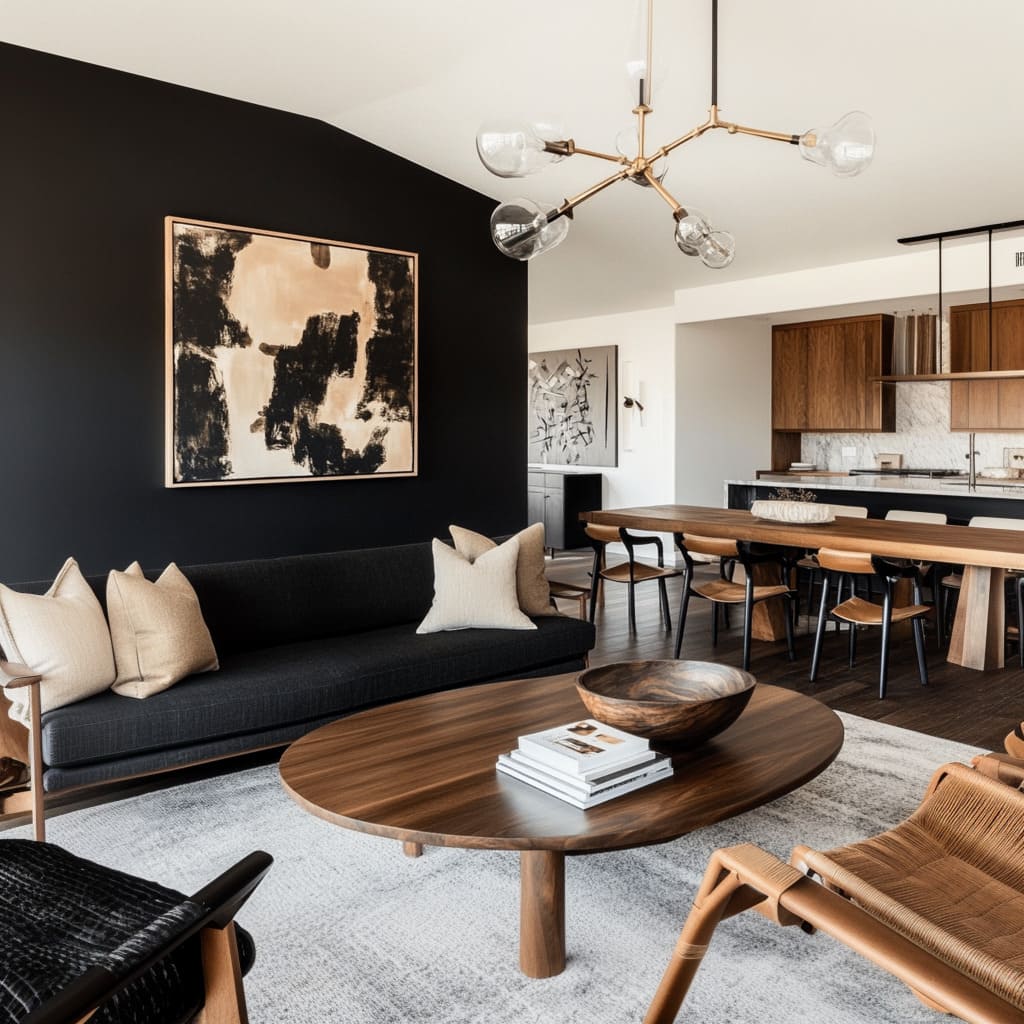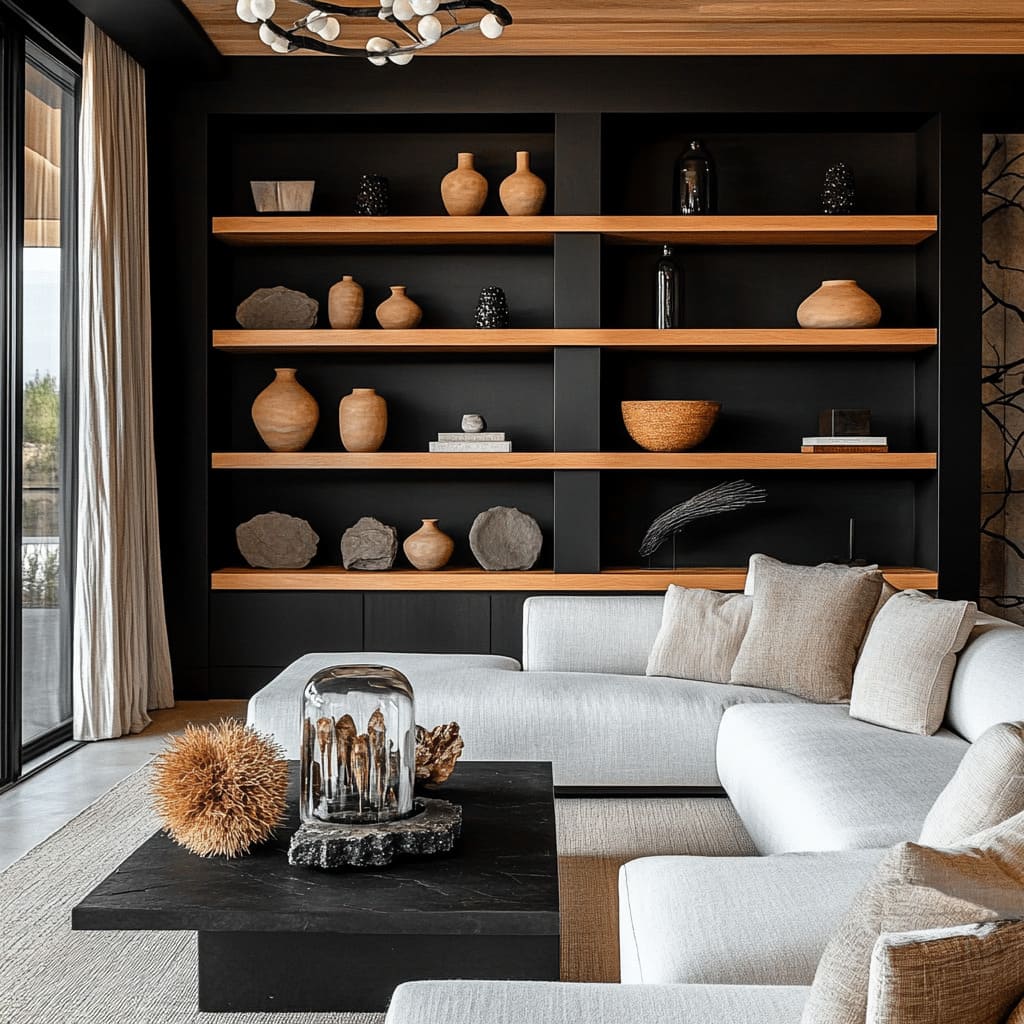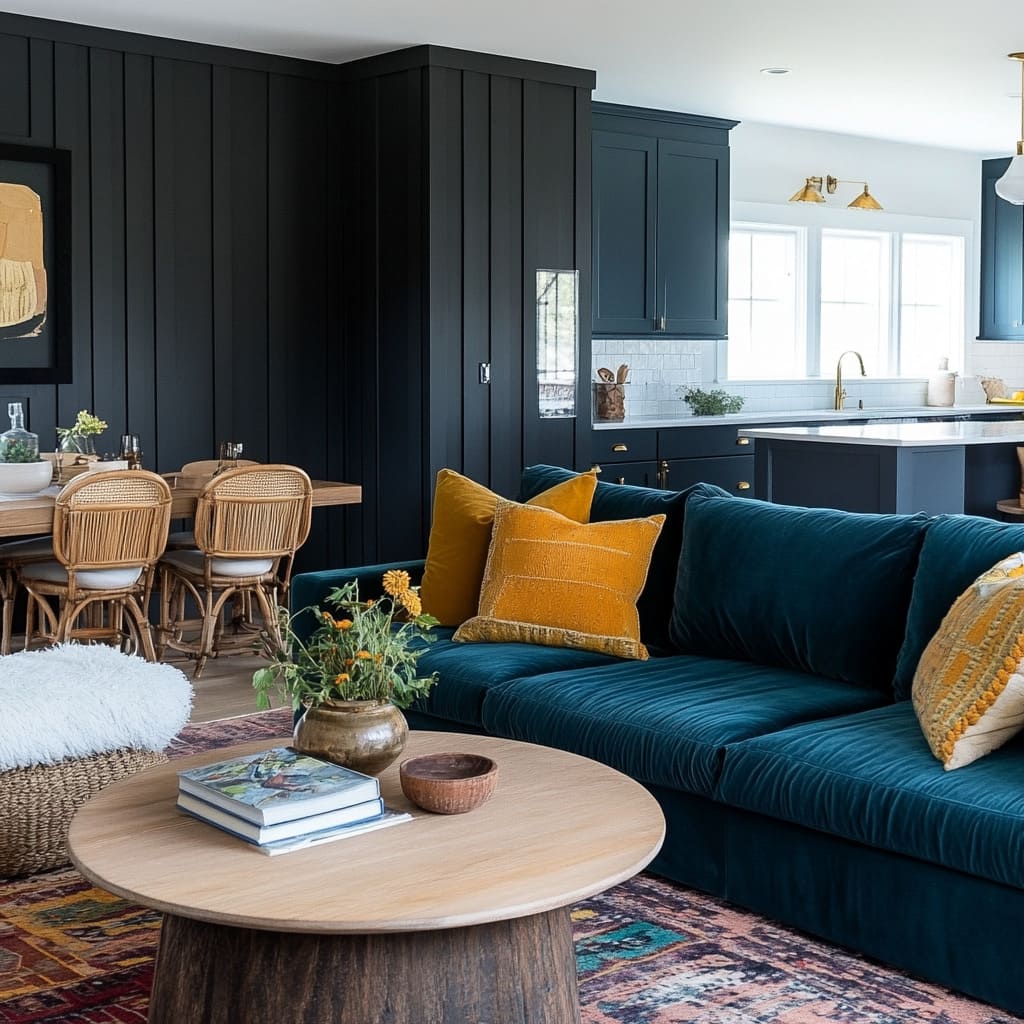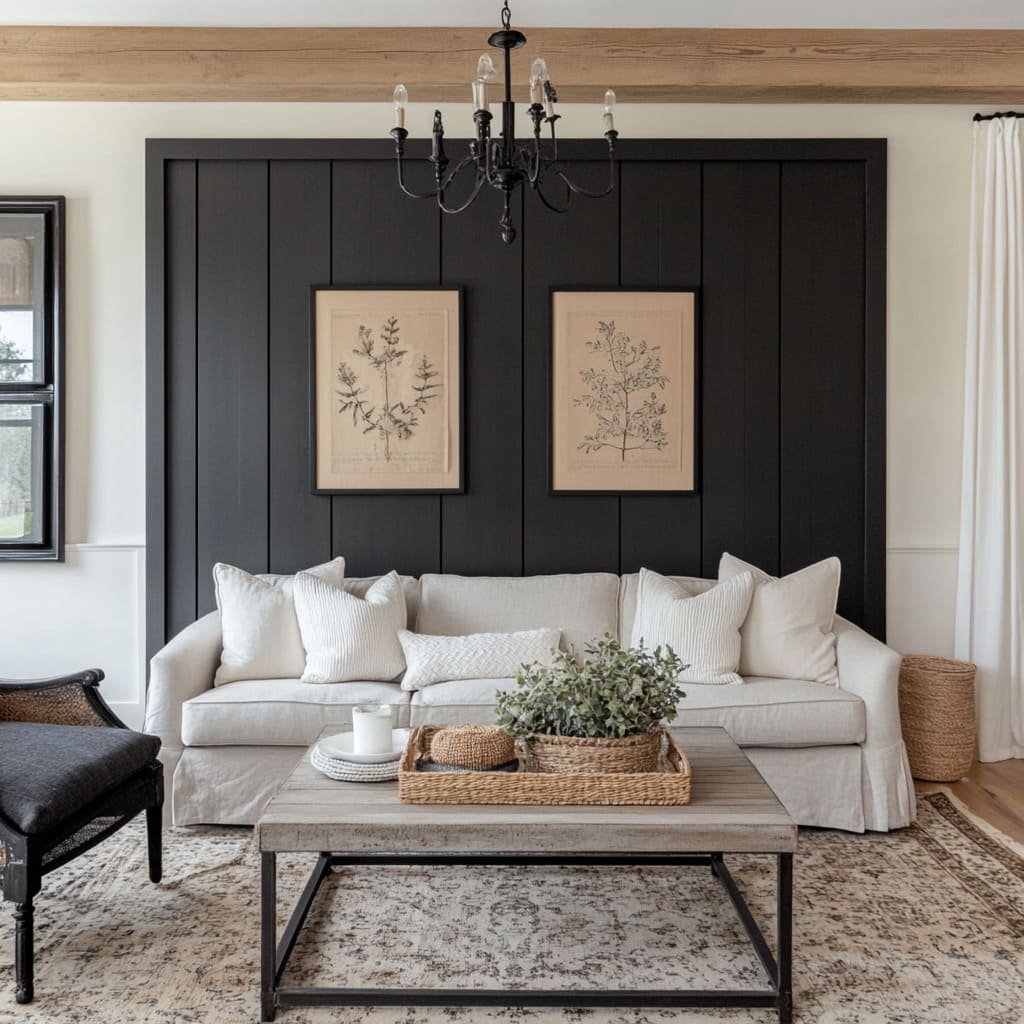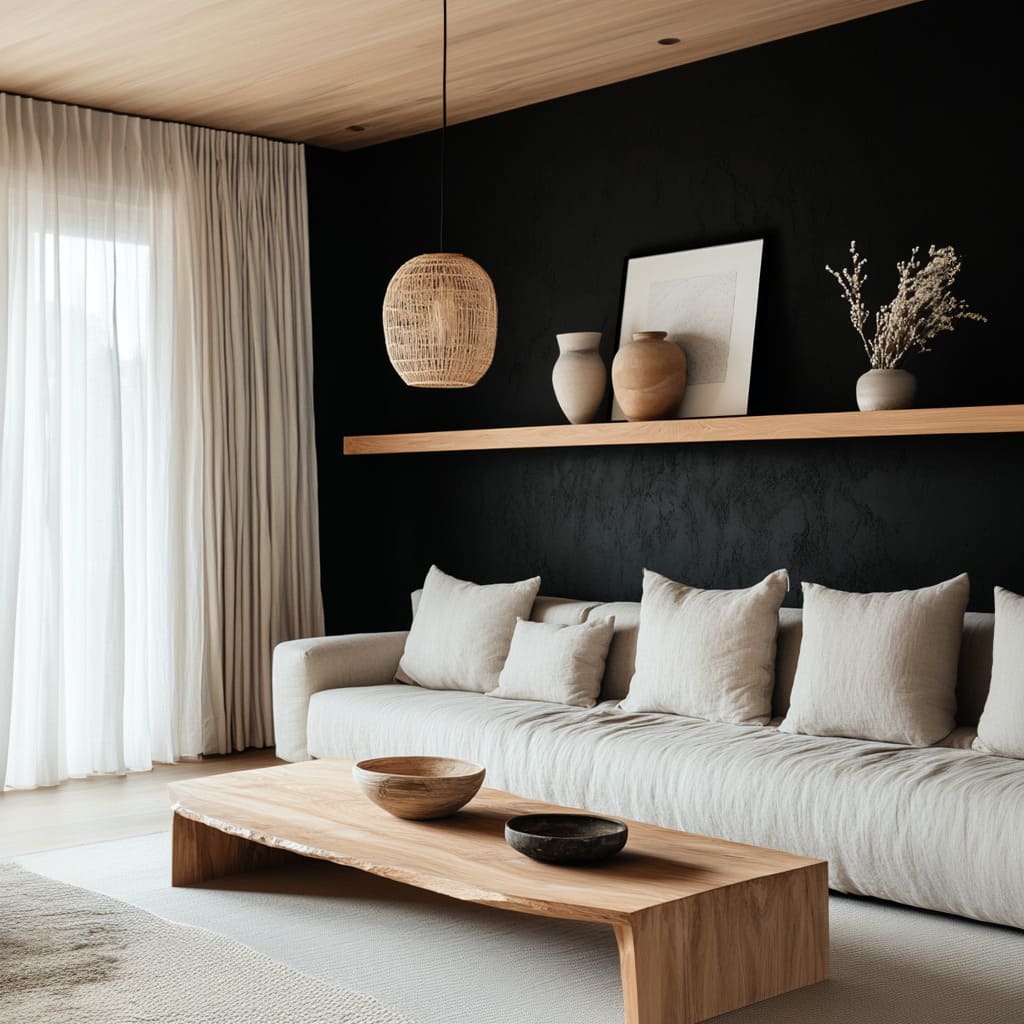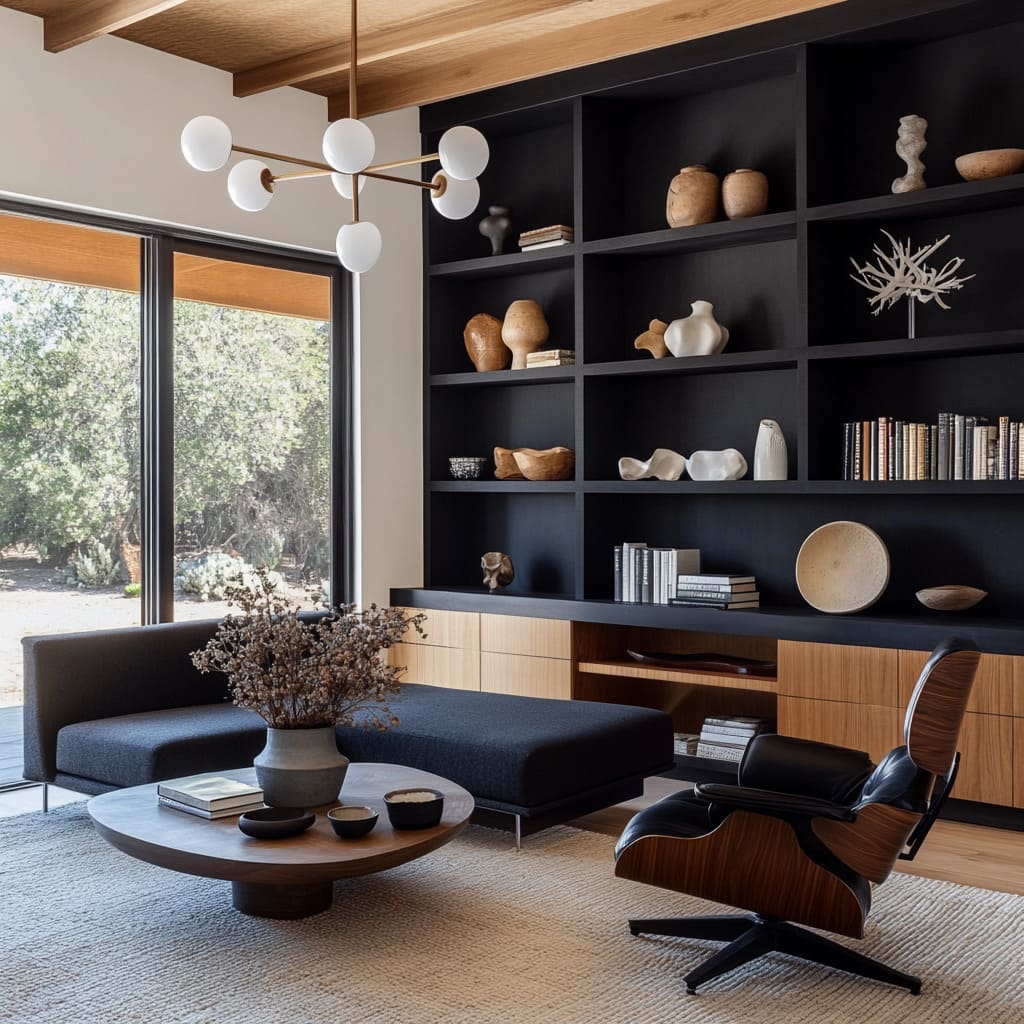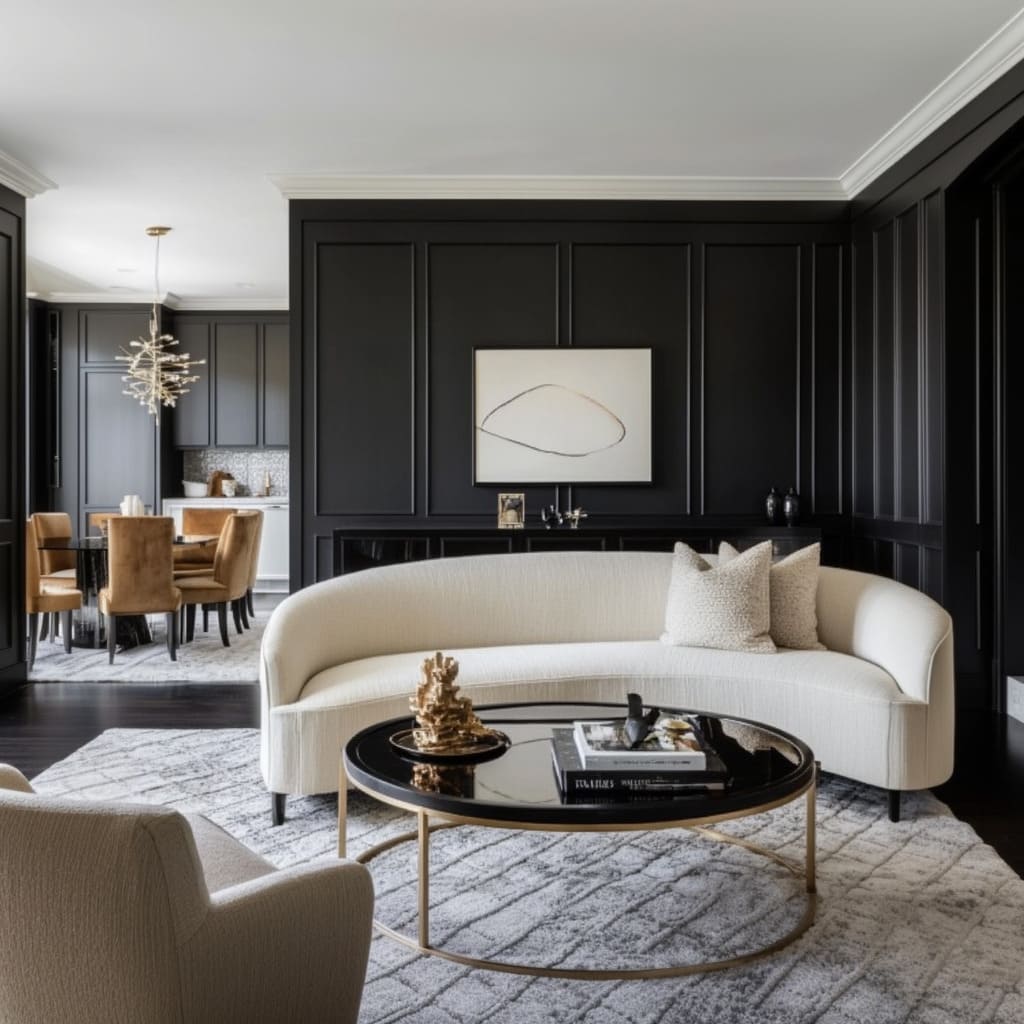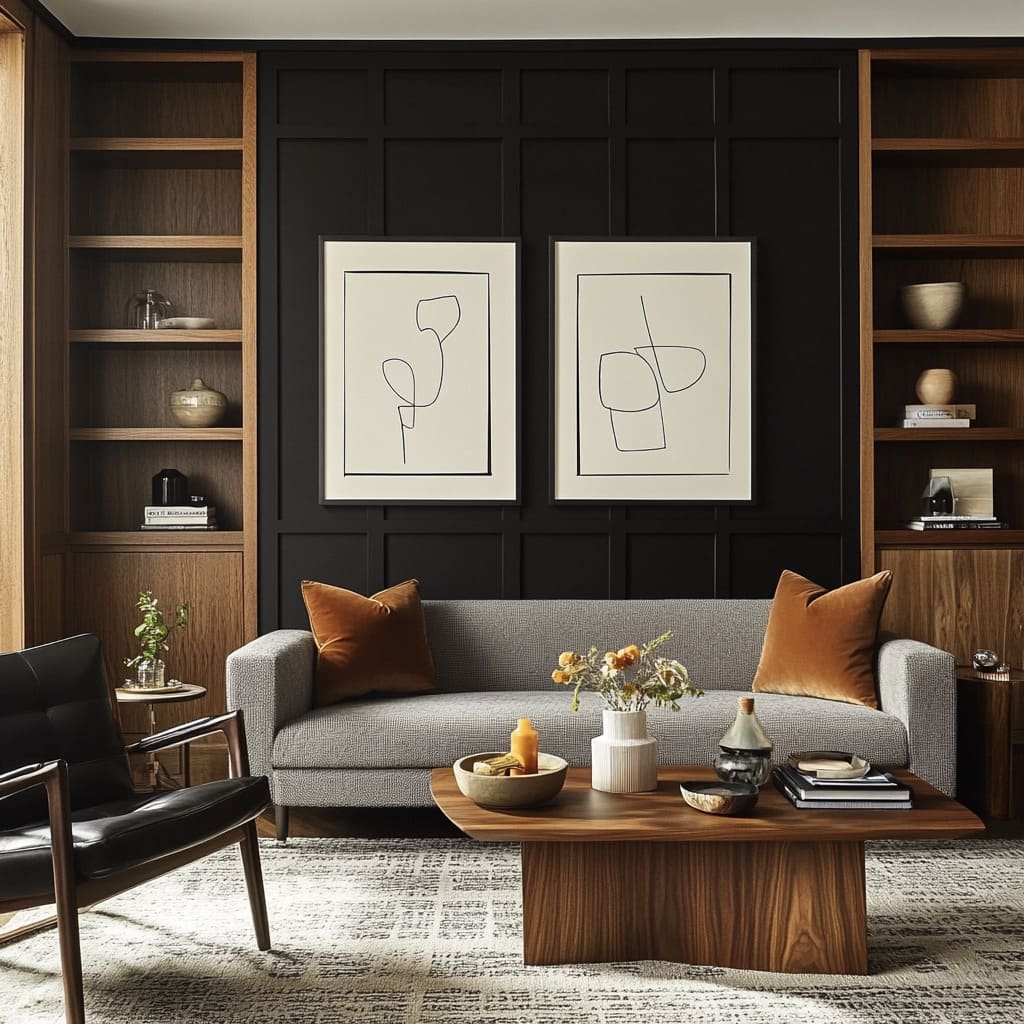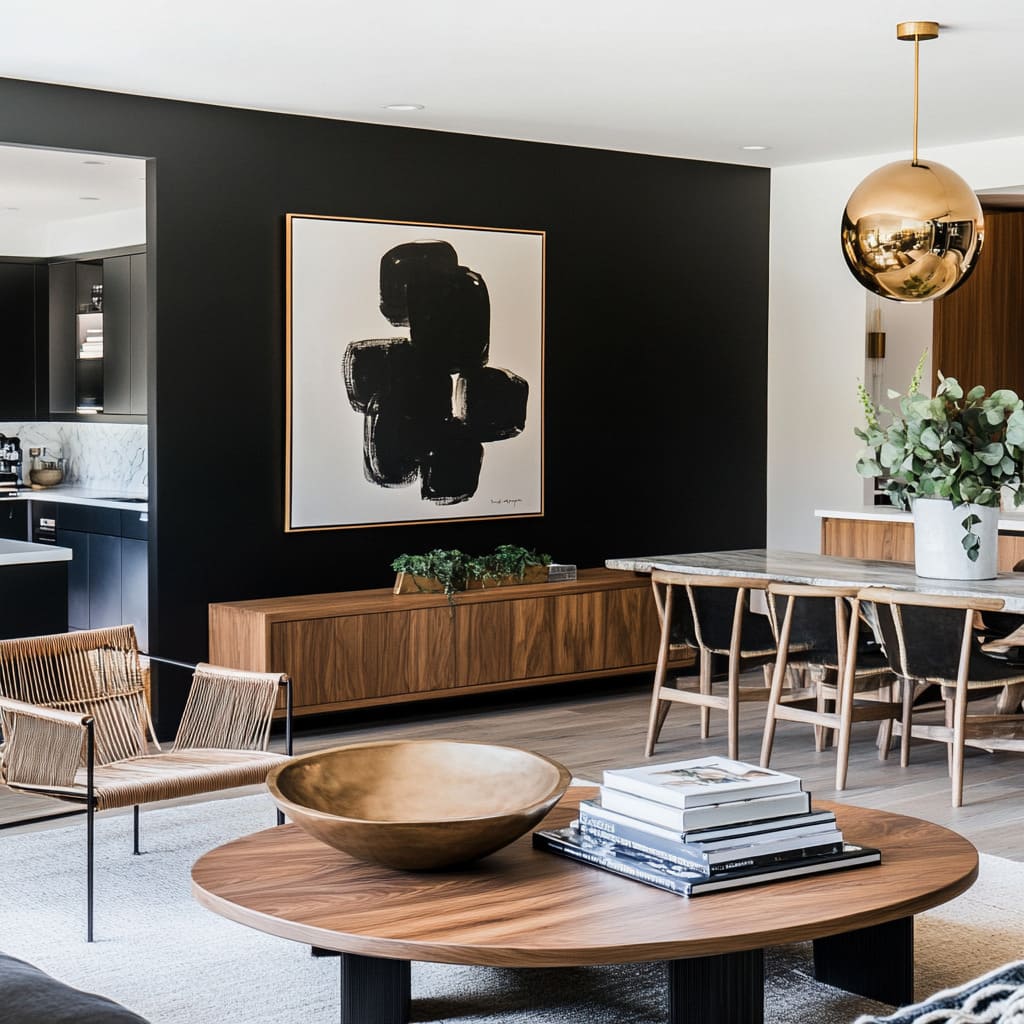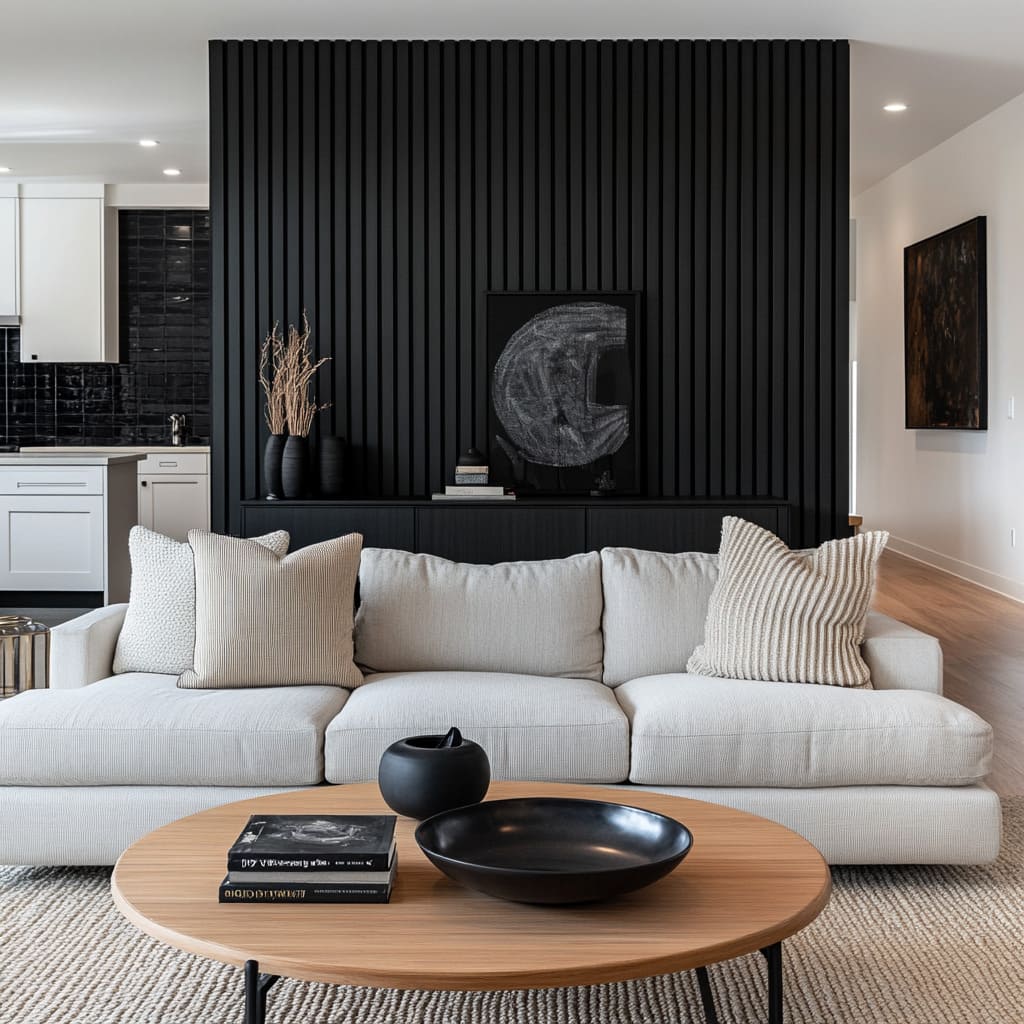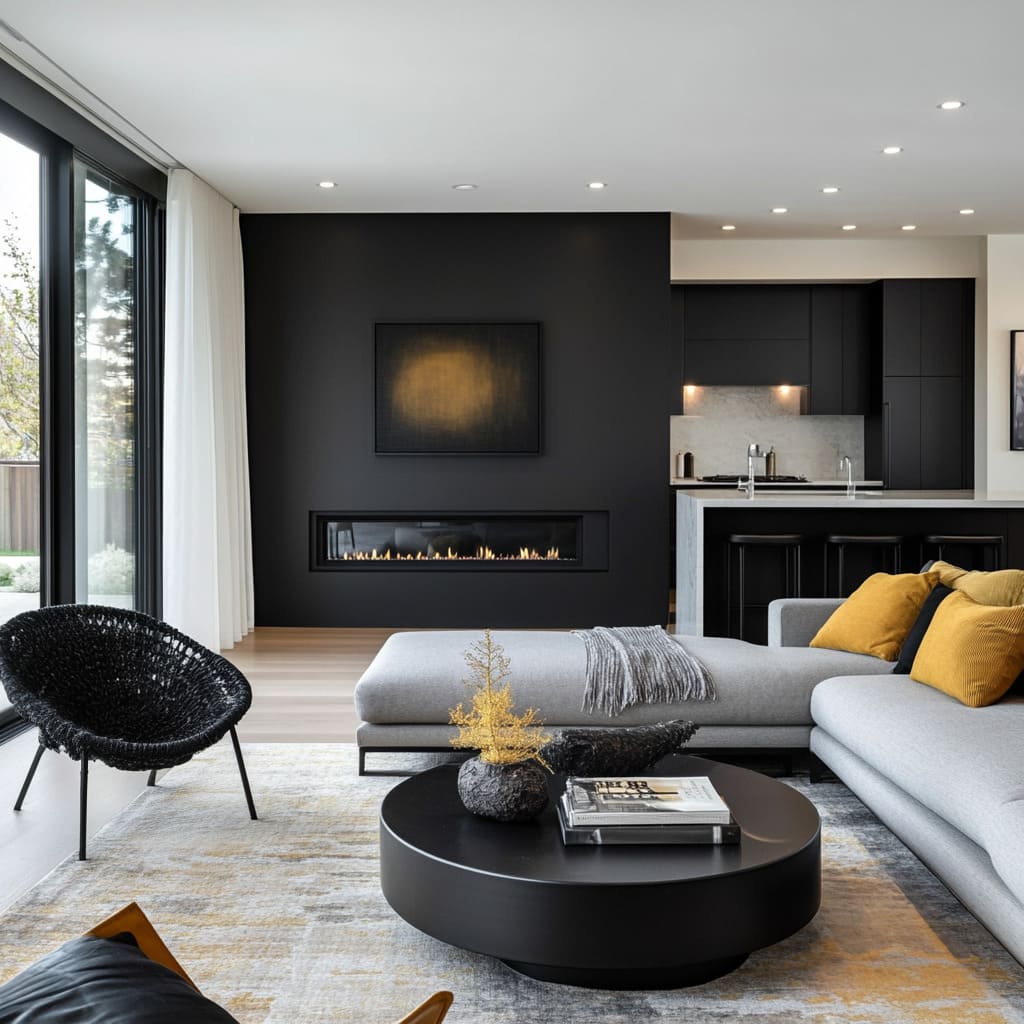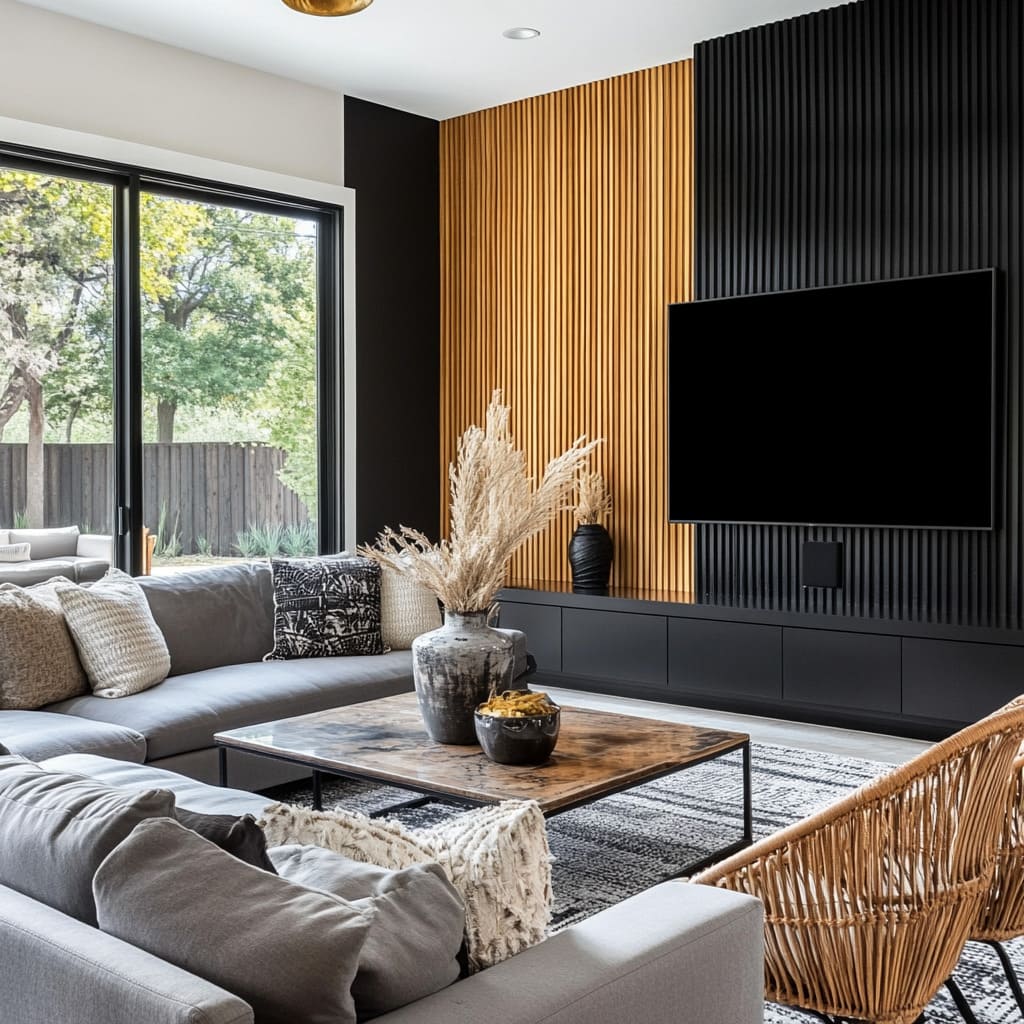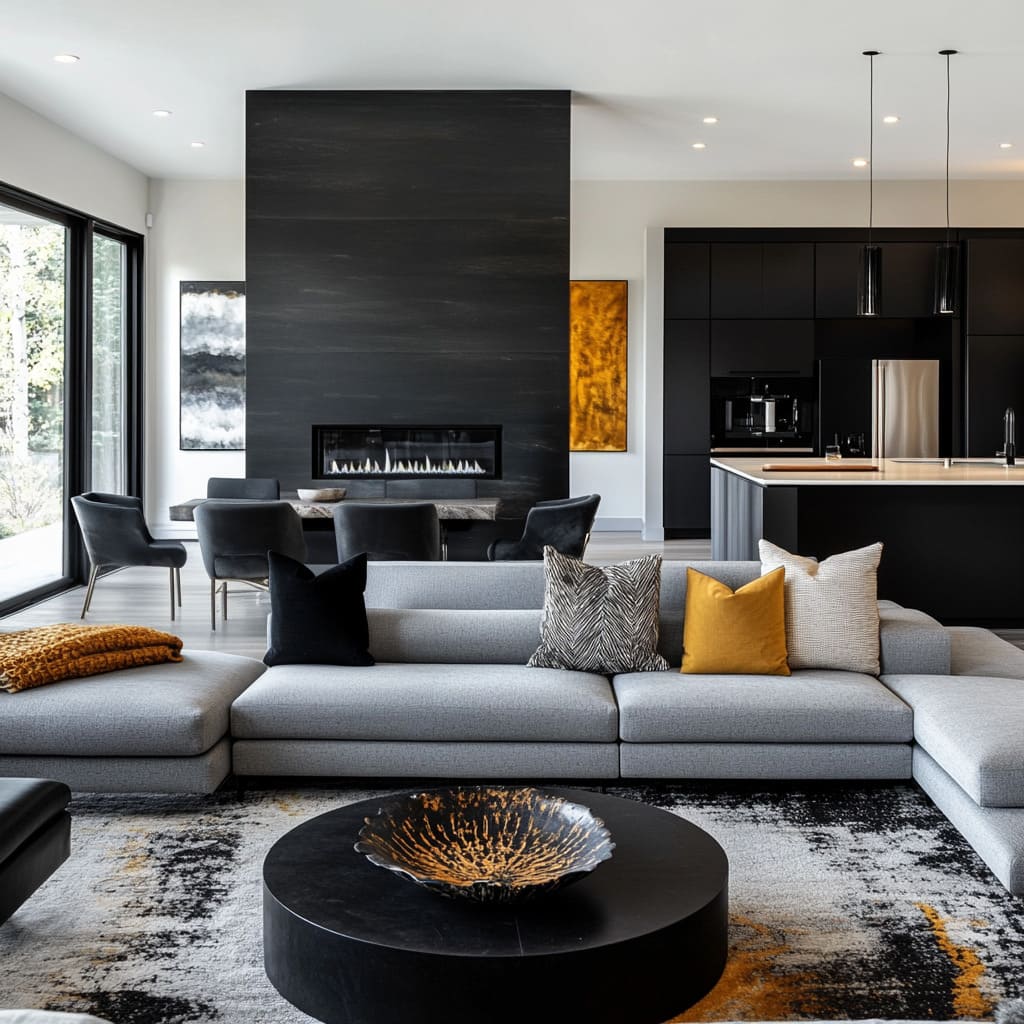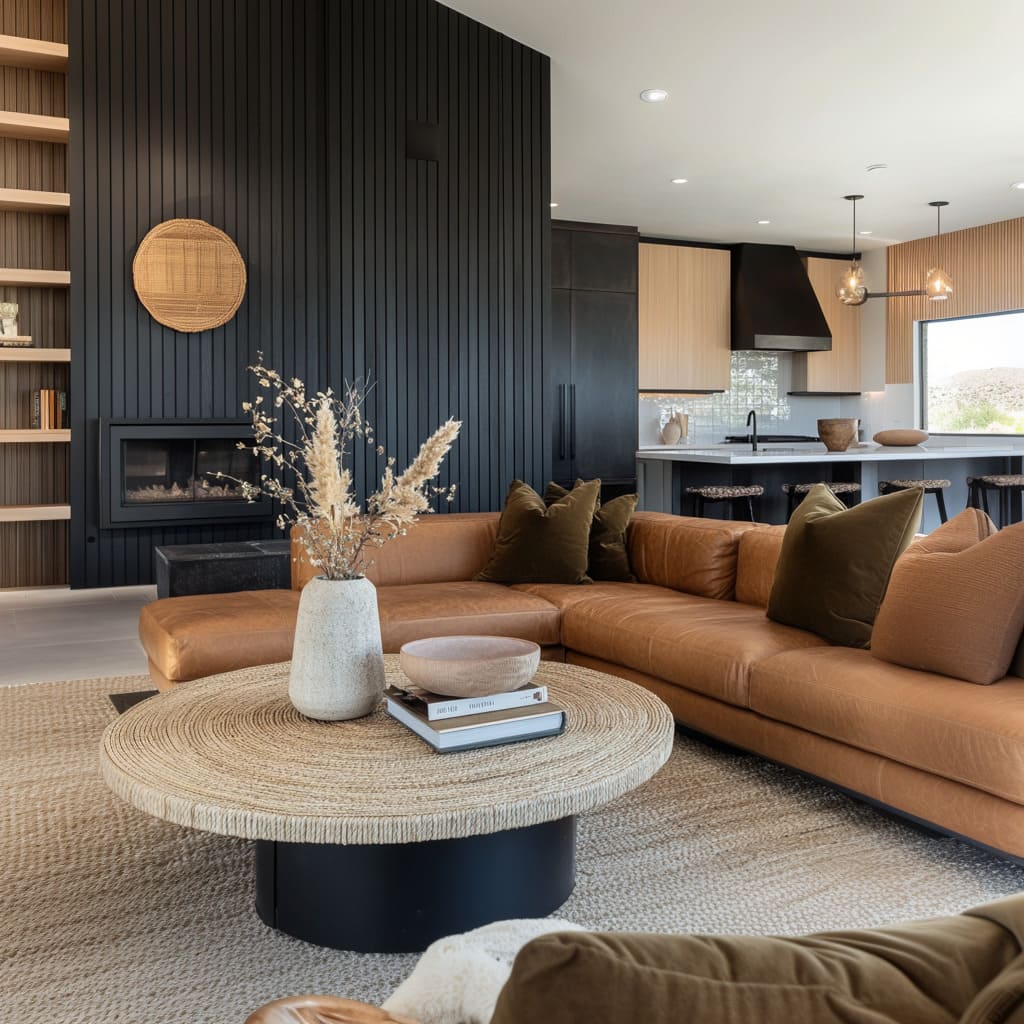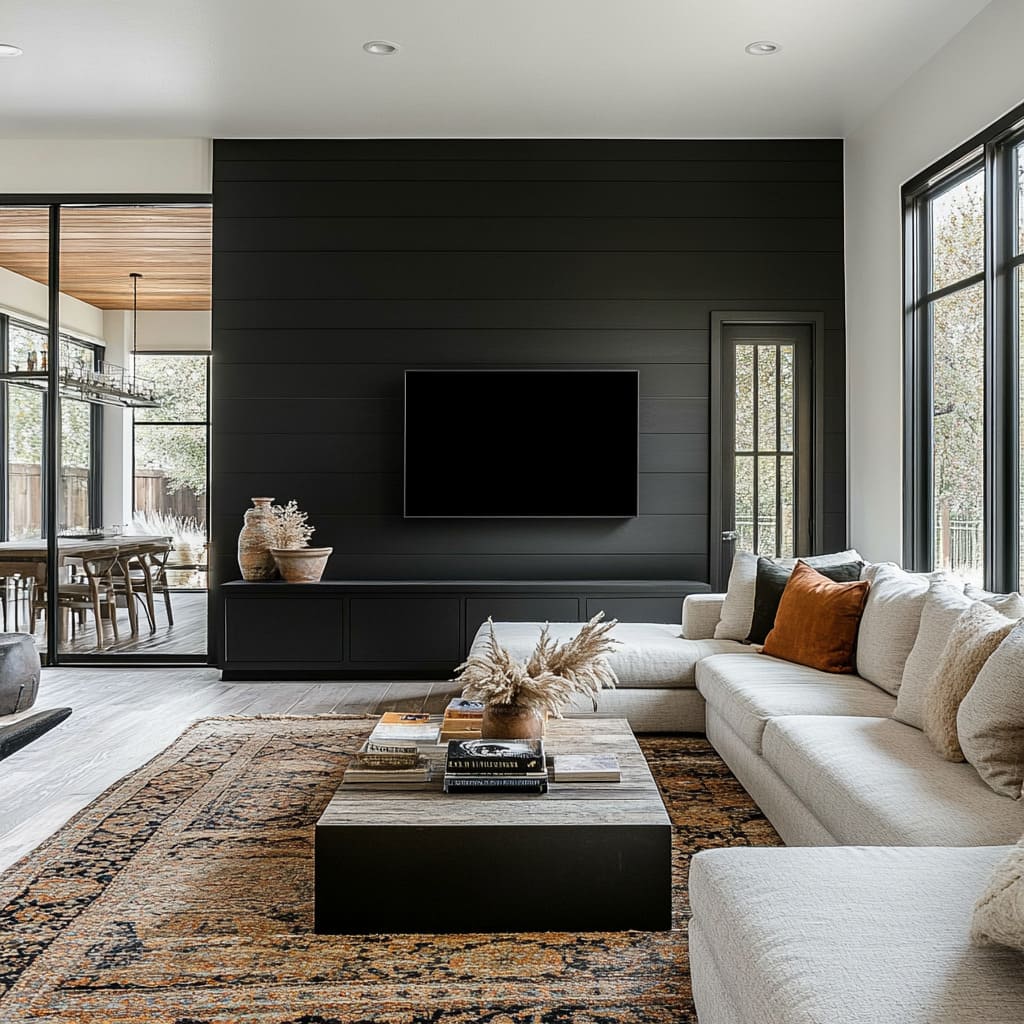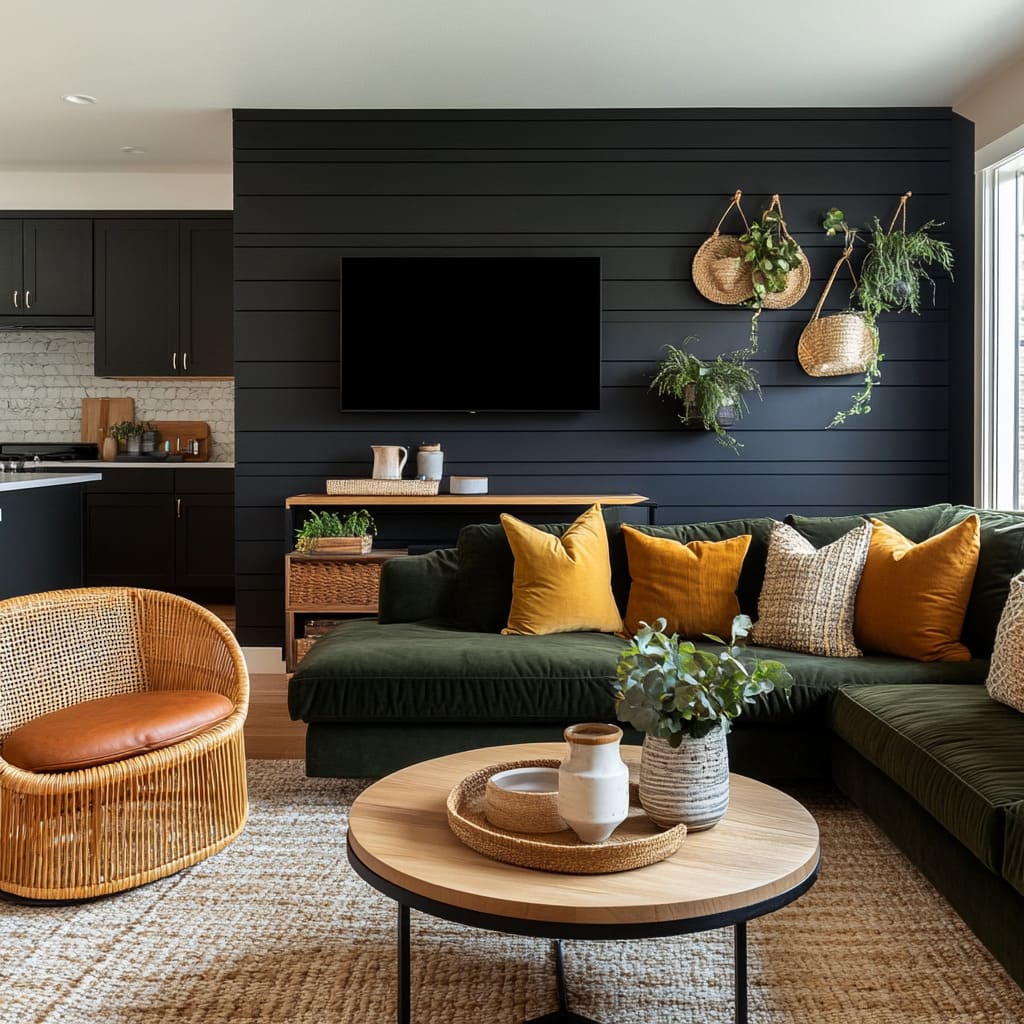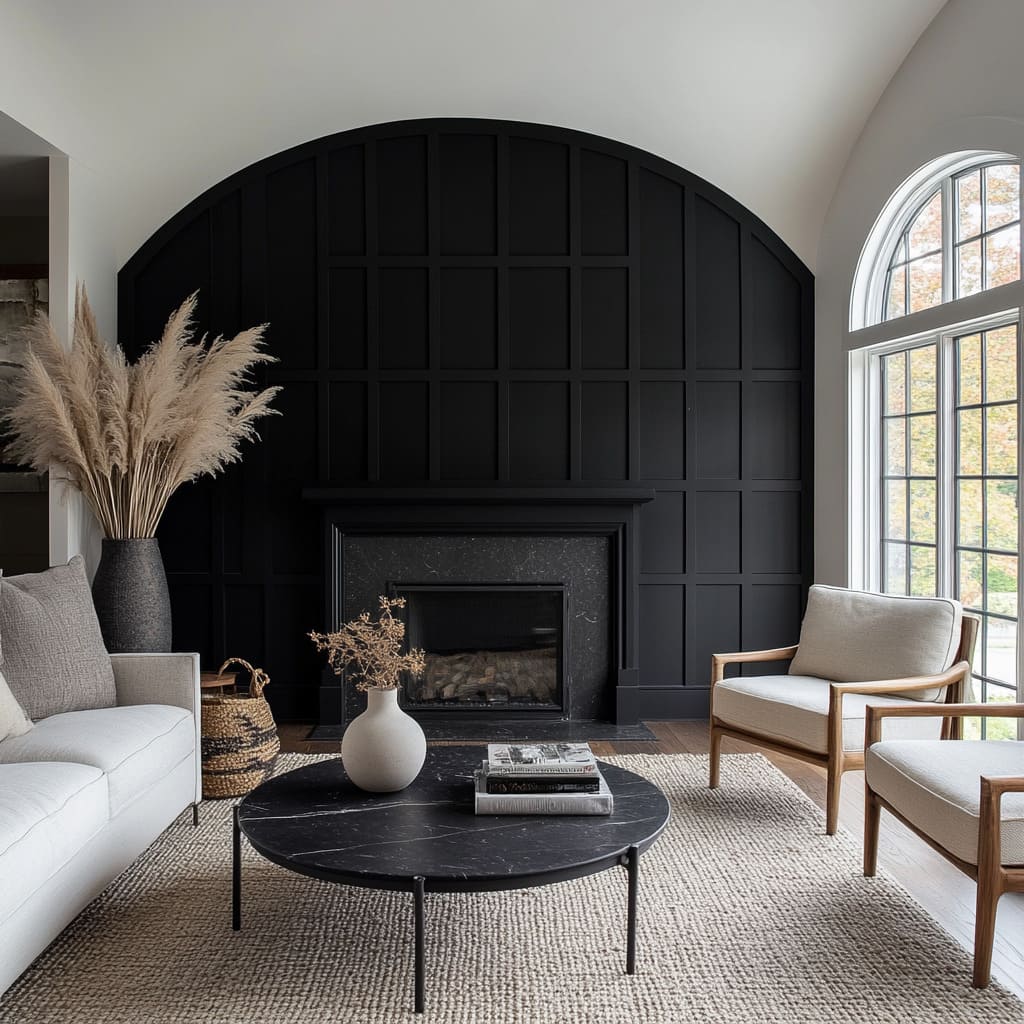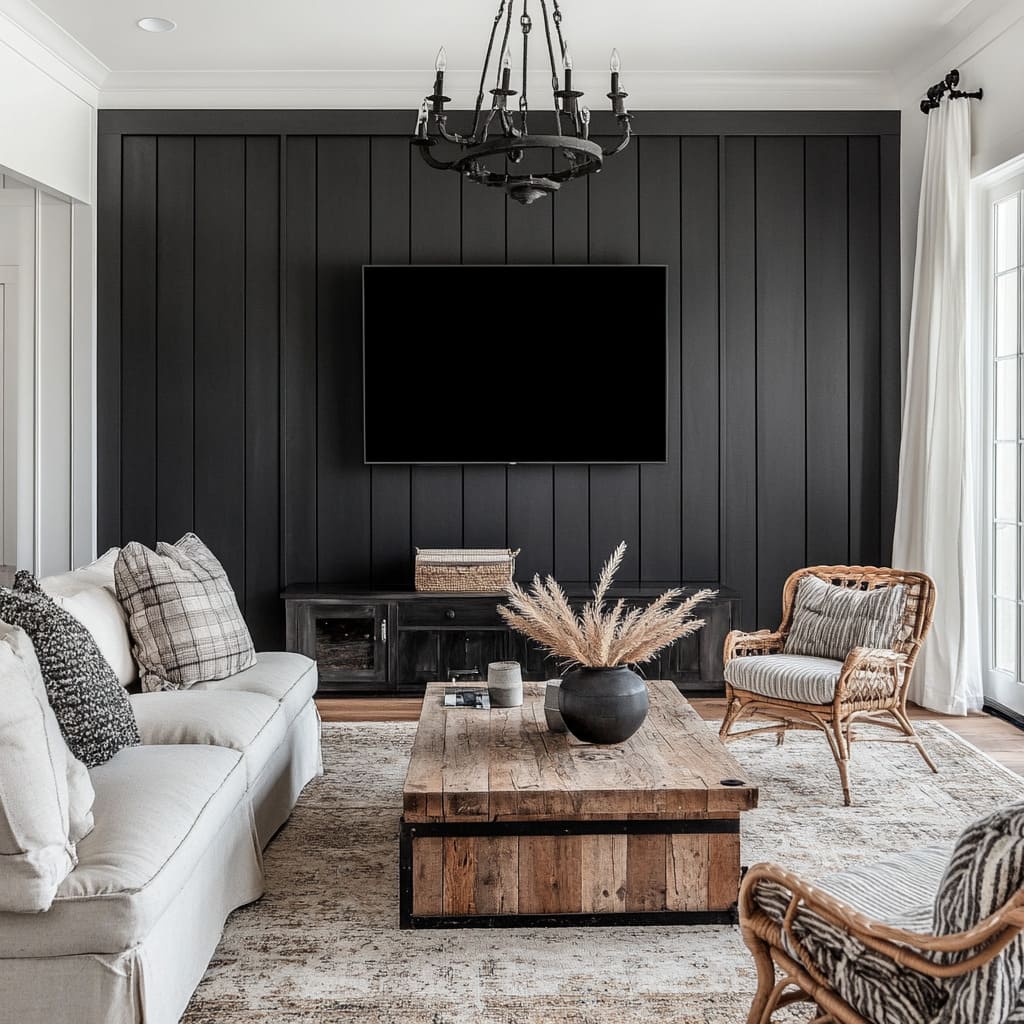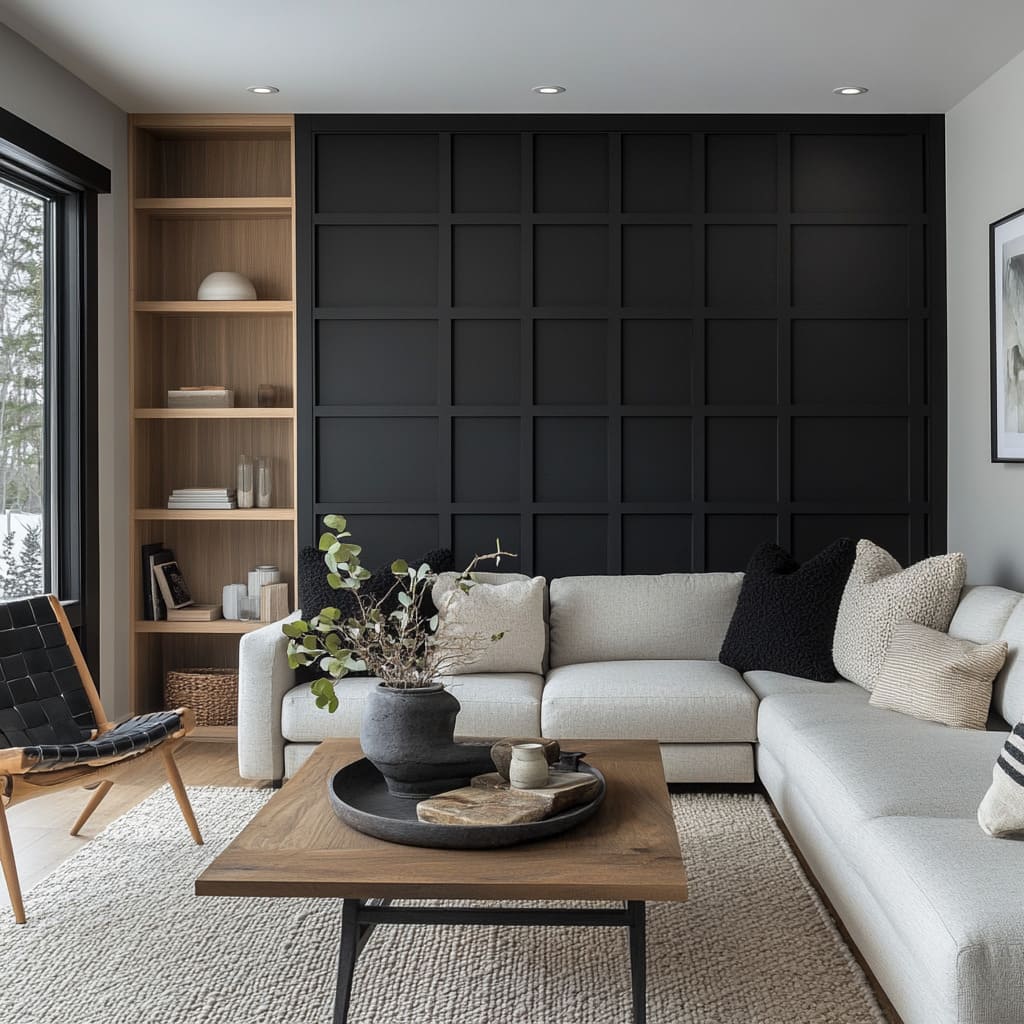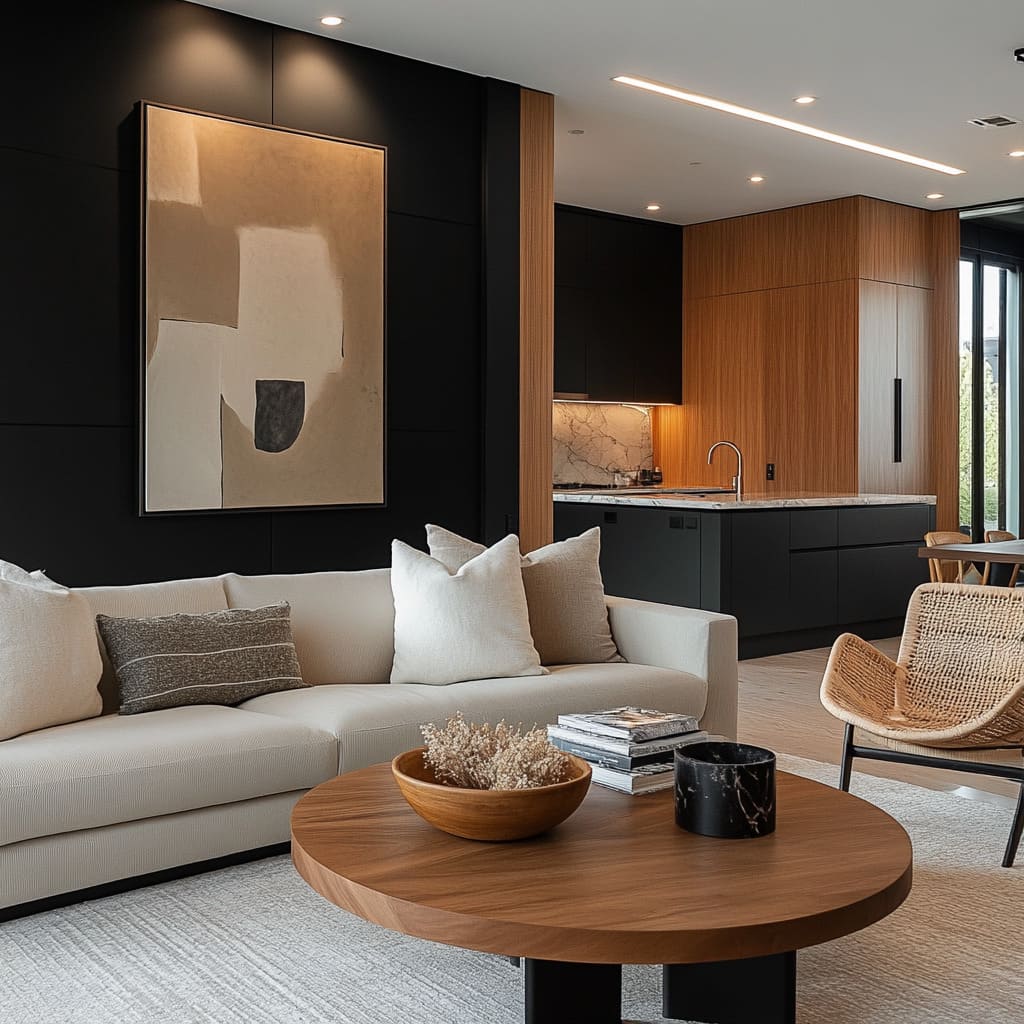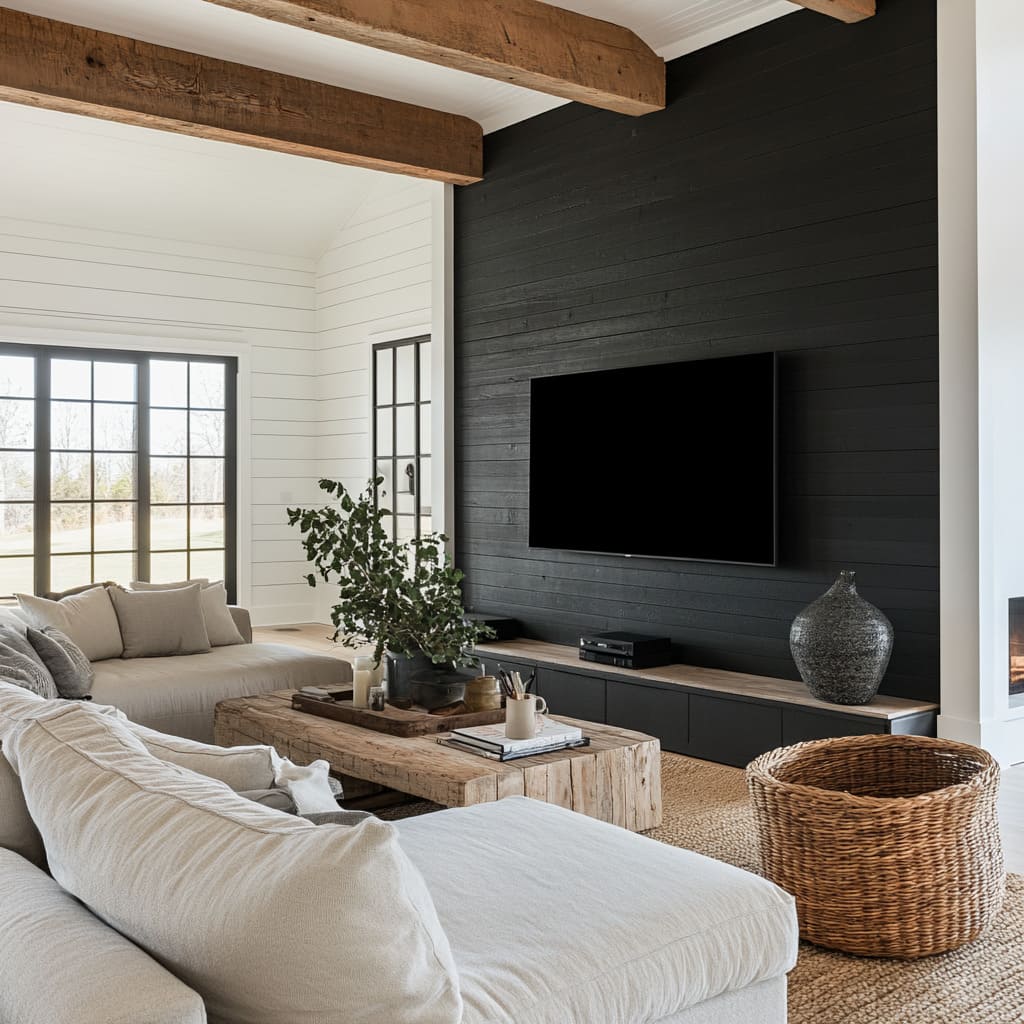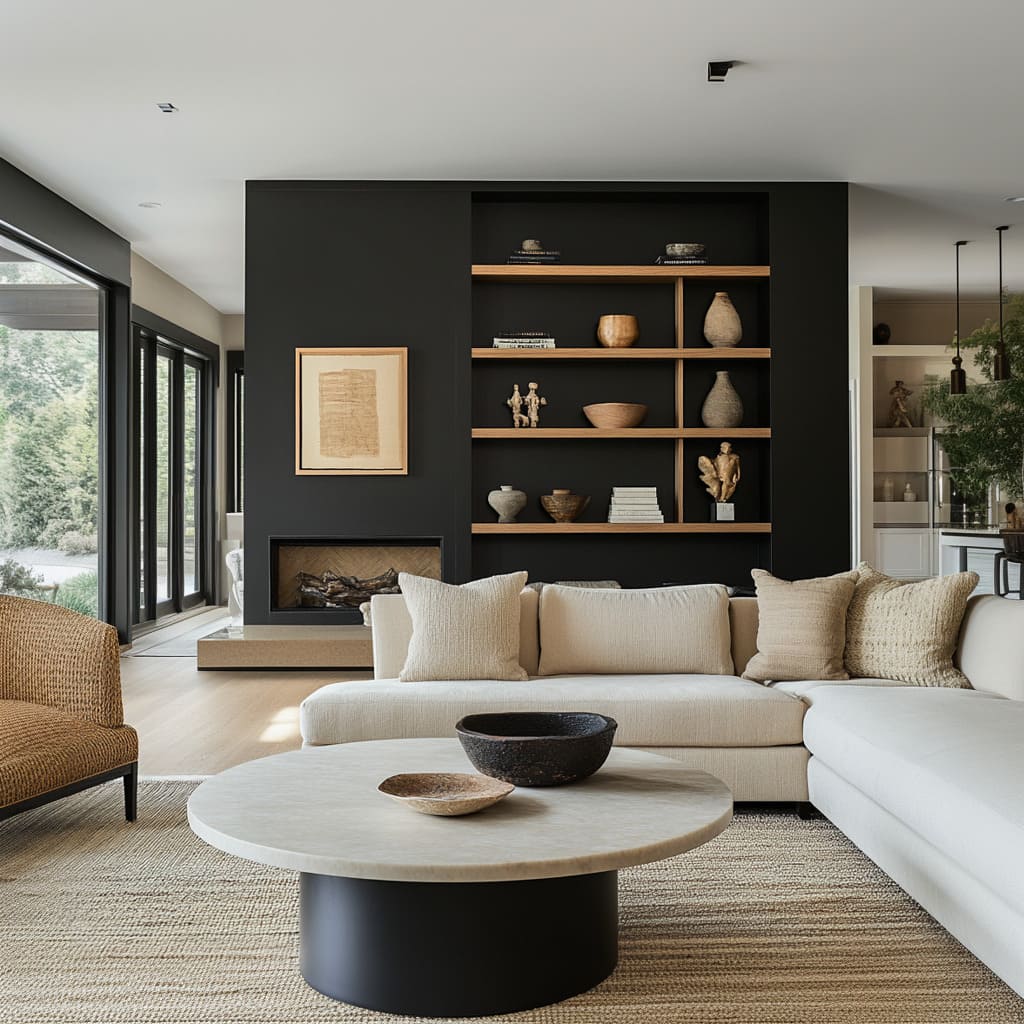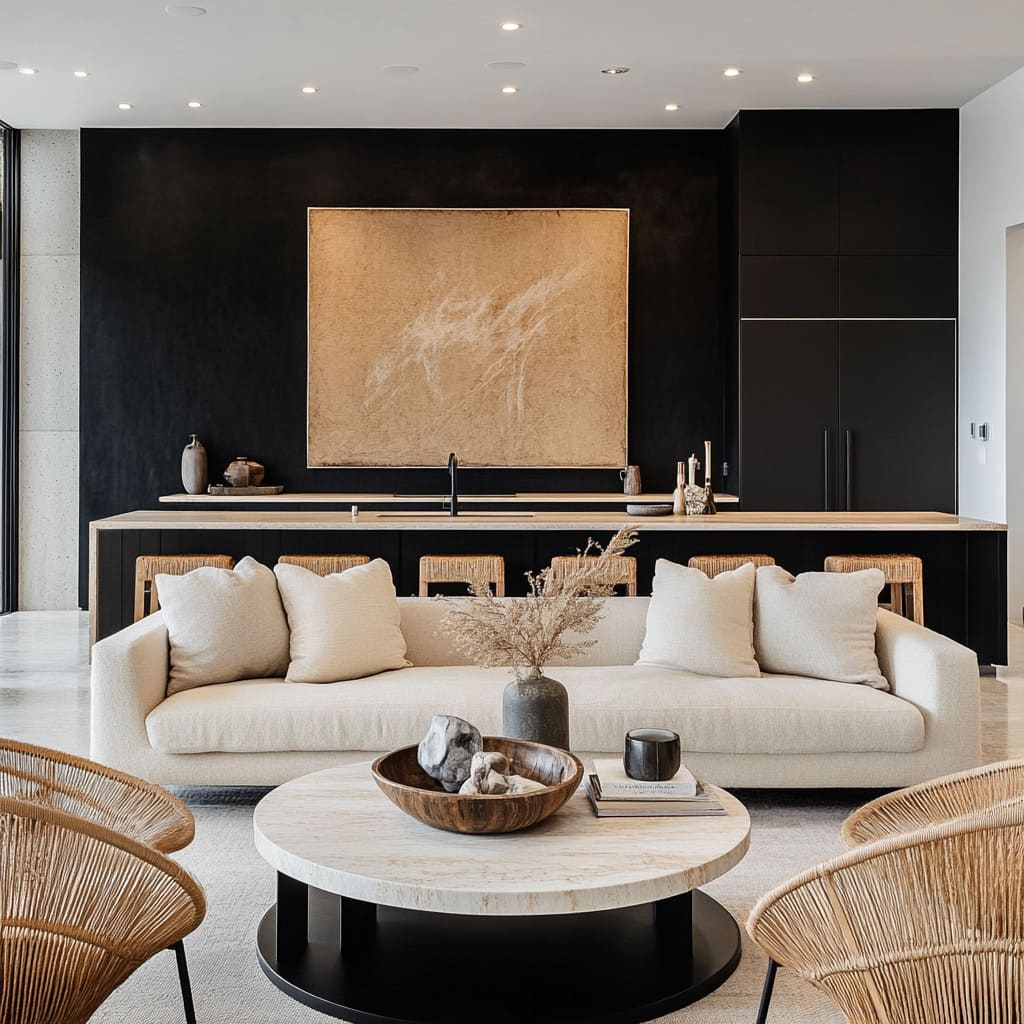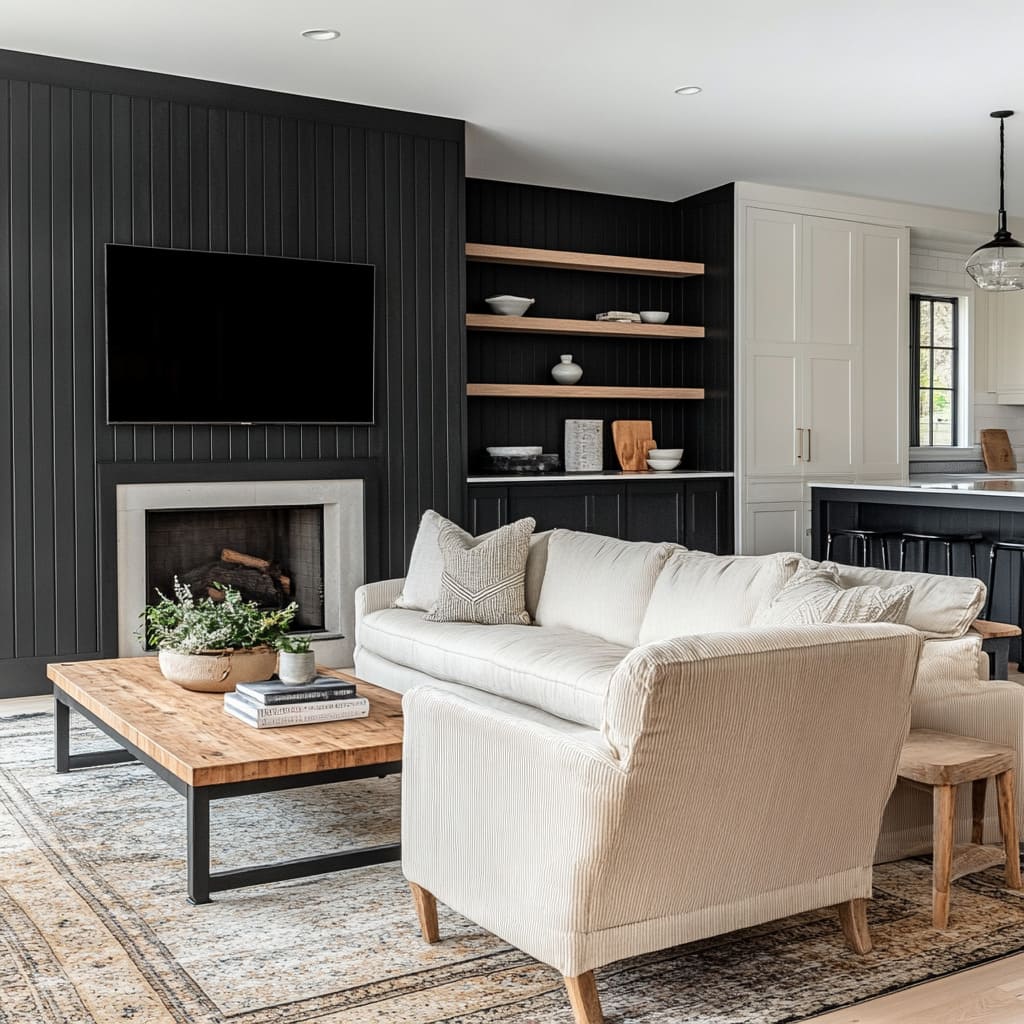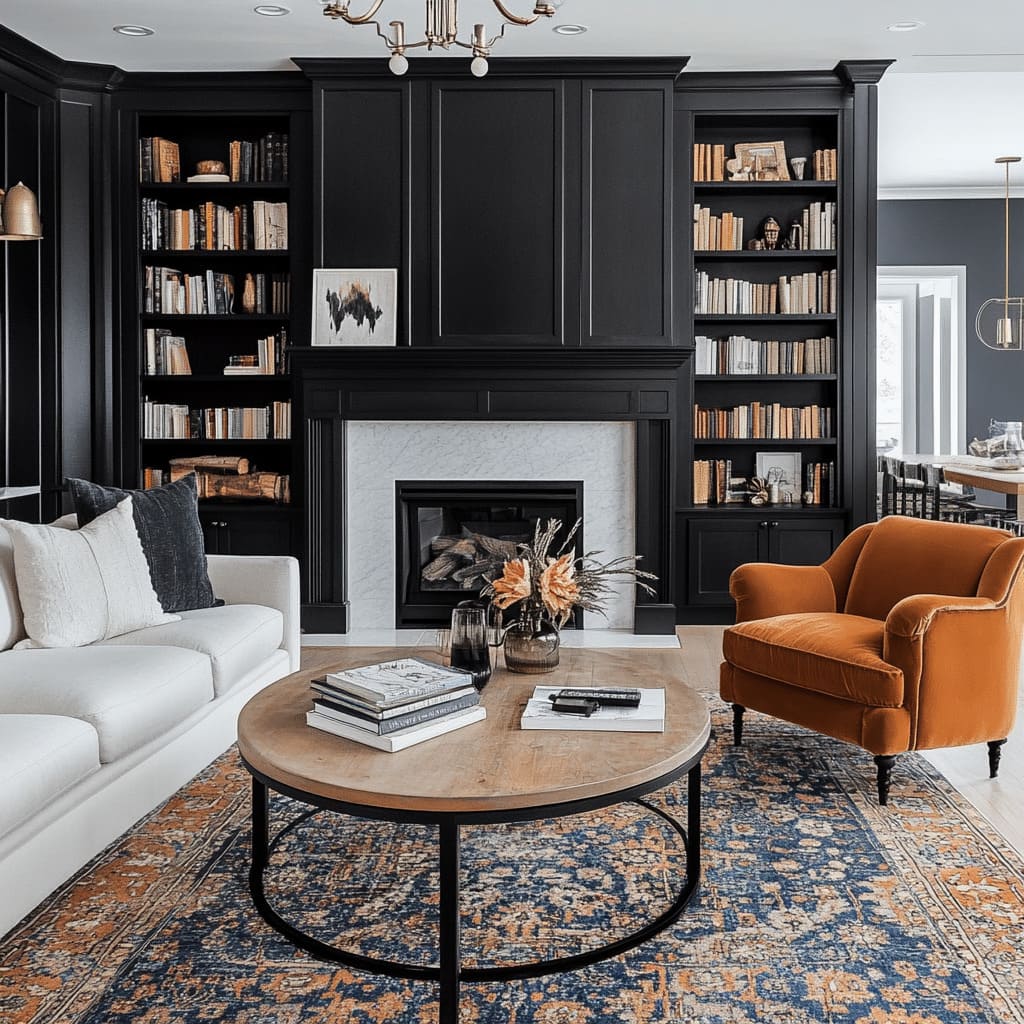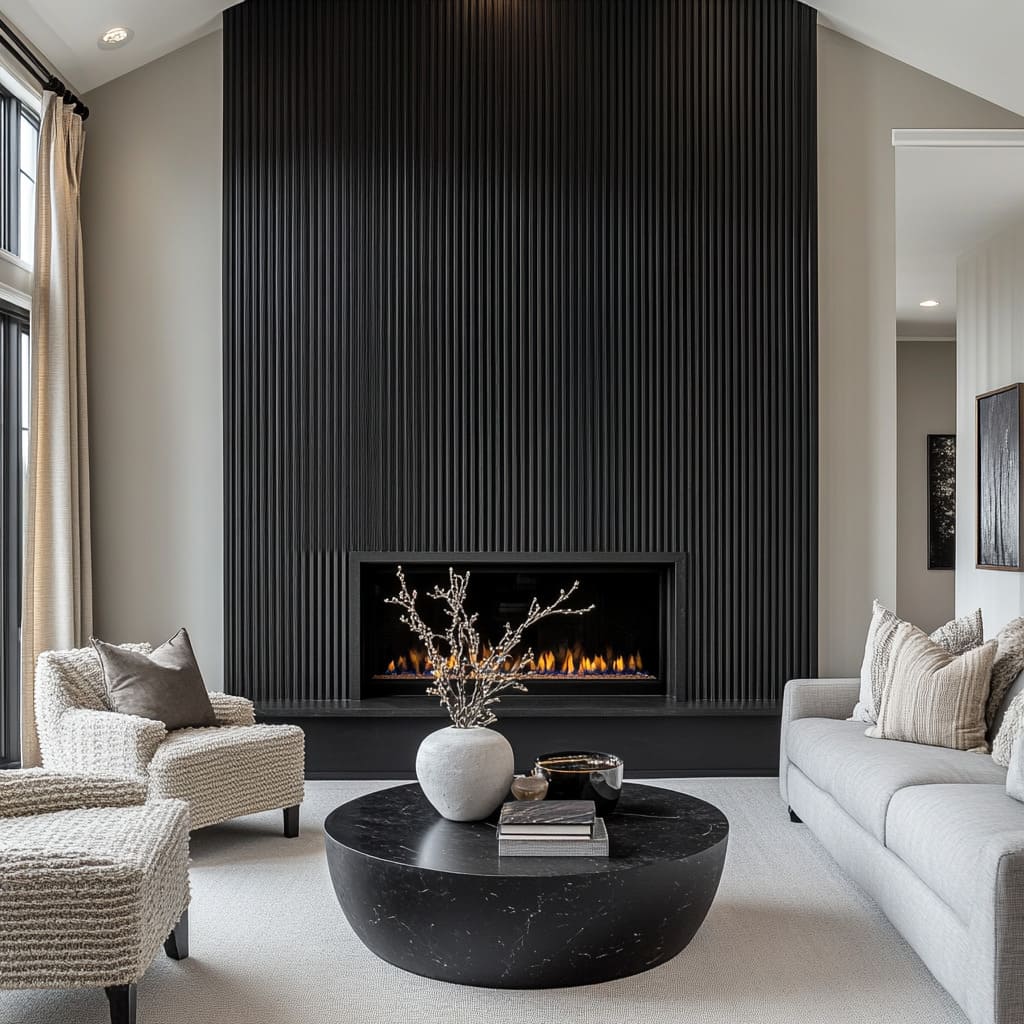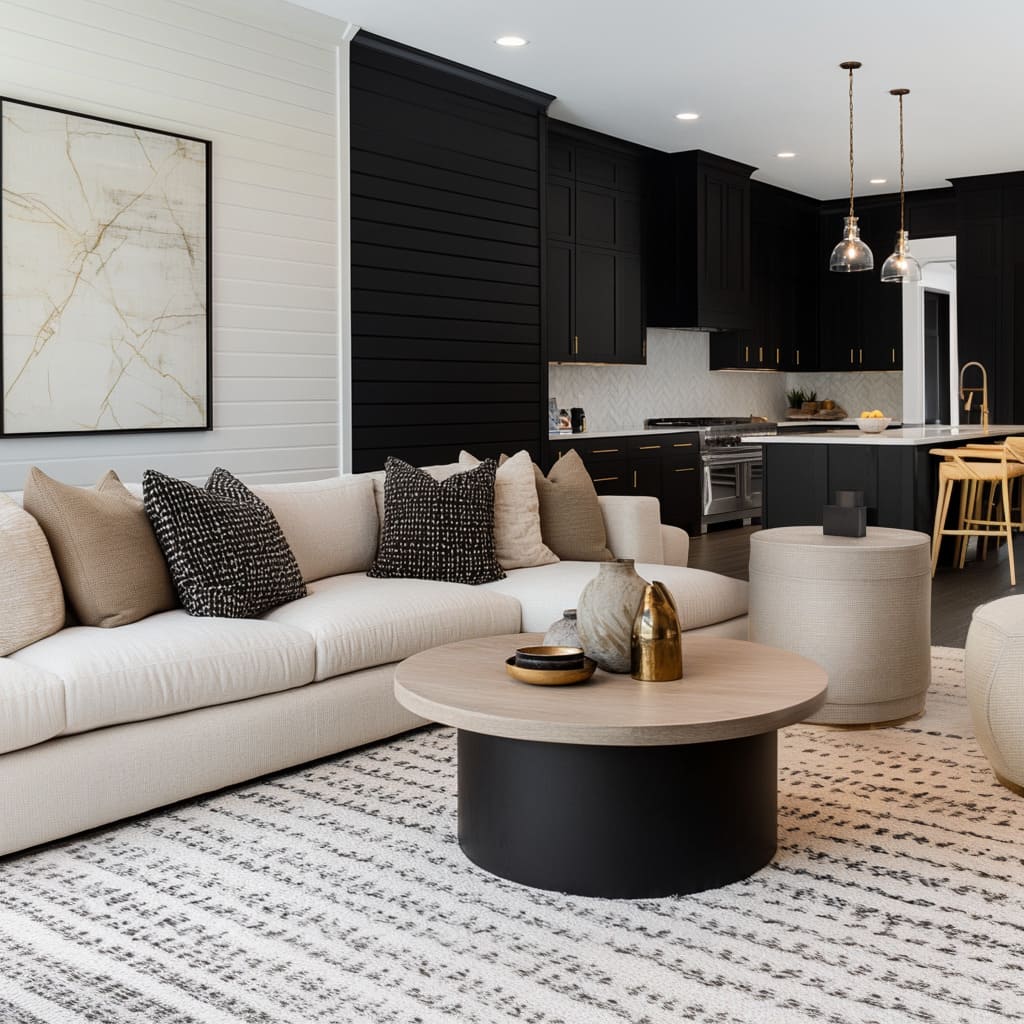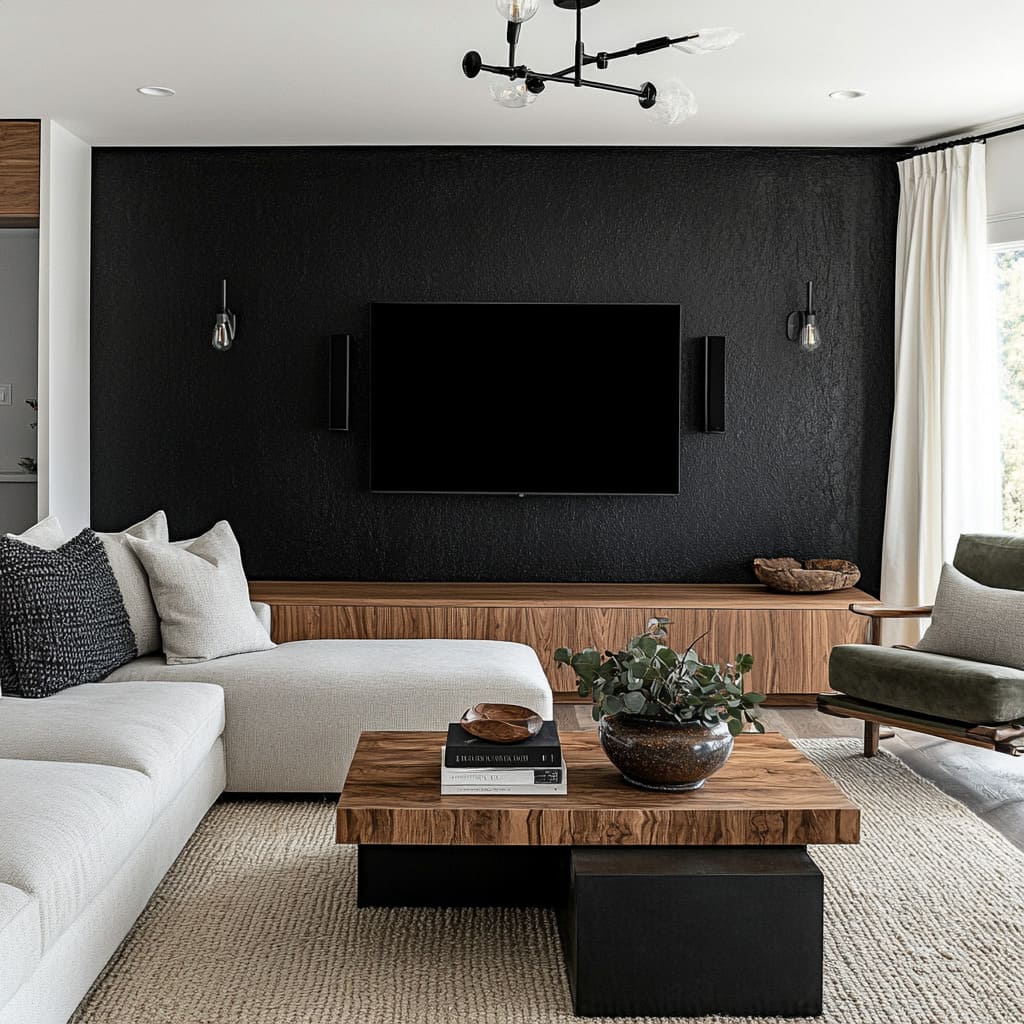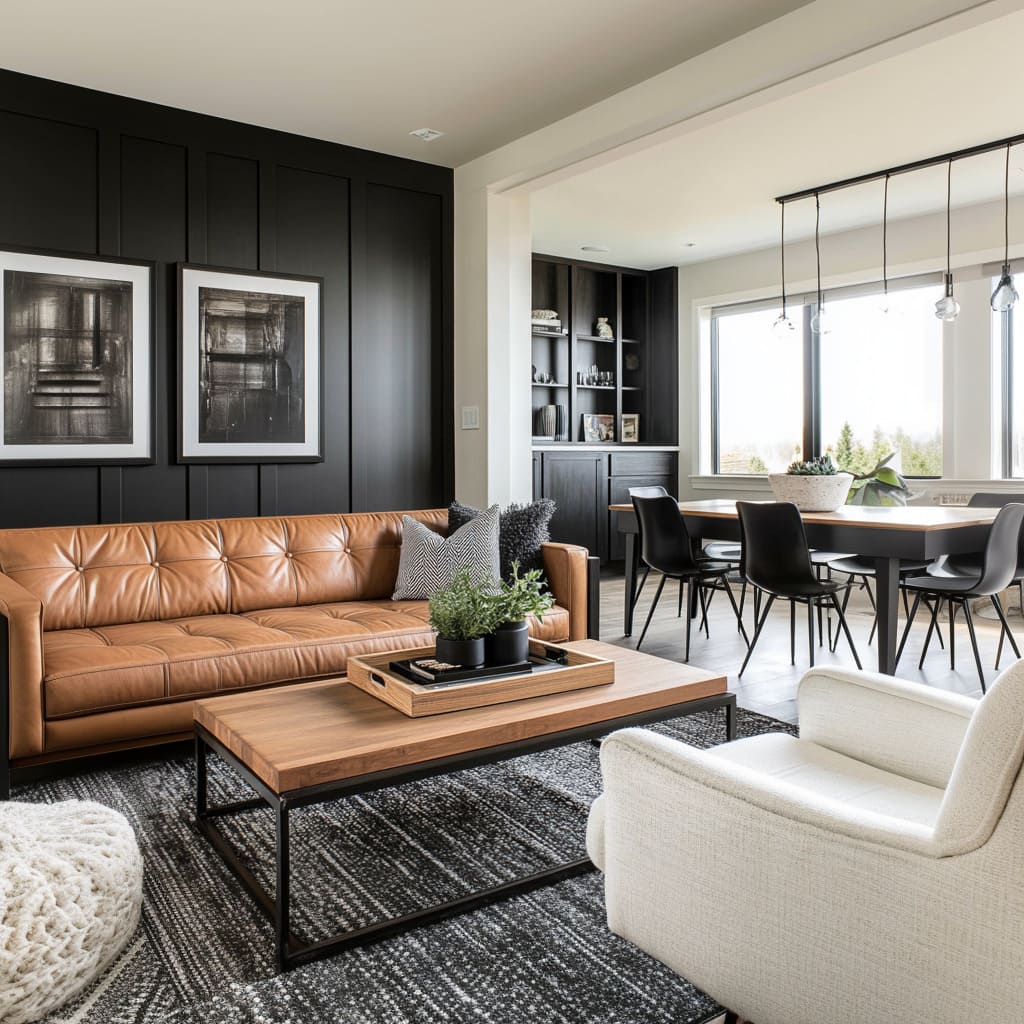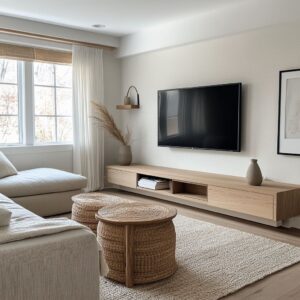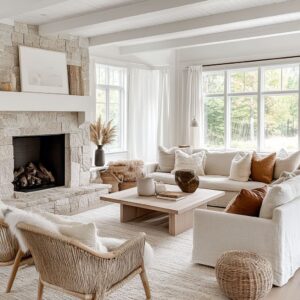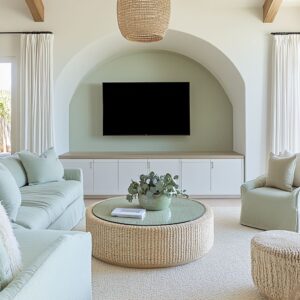A black accent wall living room can instantly shift the mood of a space, creating a striking focal point that adds depth, contrast, and sophistication. But there’s much more to these dark statement walls than meets the eye.
This article goes beyond the basics, exploring how textures, architectural details, and carefully chosen furnishings interact with black surfaces to shape a balanced and inviting atmosphere. From structured paneling that enhances dimension to thoughtful lighting that prevents the space from feeling closed in, every detail plays a role in making a black accent wall work.
We’ll also look at how different materials—like wood, stone, and textiles—soften the intensity of black, ensuring it feels grounded rather than overwhelming. Whether you’re drawn to a bold, modern aesthetic or a warm, layered look, this guide will break down the essential design strategies that make black walls feel intentional and refined.
Emphasizing Depth Through Texture
A black feature wall living room can make a strong statement, but without the right texture, it risks feeling too flat or heavy. Texture is key to keeping the space visually dynamic, adding depth that changes throughout the day as light shifts.
The best approaches go beyond a simple coat of paint, using materials that introduce dimension and subtle movement.
Fluting and Slats: Creating Light and Shadow Play
Vertical grooves, whether in wood, MDF, or plaster, break up a solid black wall and create an interplay of highlights and shadows. This effect changes depending on the time of day and the angle of natural or artificial light.
In a room with high ceilings, fluted paneling enhances the sense of height, while in a smaller space, thinner slats can introduce rhythm without feeling overpowering.
Rough or Matte Plaster: Organic Depth
A smooth black wall might look sharp, but a plastered finish adds a natural, hand-applied quality that makes it feel more inviting. Slightly uneven plaster absorbs and reflects light unevenly, creating soft variations in tone that prevent the surface from looking too uniform.
This approach is particularly effective in rooms inspired by Japandi, Mediterranean, or industrial styles, where organic imperfections enhance the atmosphere.
Board-and-Batten or Grid Paneling: Architectural Detail with Purpose
Paneling techniques like board-and-batten or grid layouts add subtle depth while keeping the overall look structured. Even when painted entirely black, the contrast between raised sections and recessed areas introduces an understated elegance.
This method works well in both traditional and modern interiors, allowing a black feature wall to feel intentional rather than overwhelming.
Design Tip: Choosing the Right Texture for Your Lighting
The impact of texture depends heavily on how much light the room receives. If a space gets plenty of natural light, a bold, structured texture—such as deep fluting or high-contrast paneling—will stand out beautifully.
In a room with limited light, a more subdued texture, like a soft plaster or fine vertical grooves, can create depth without making the space feel closed in. The goal is to find a balance that enhances the black wall rather than letting it dominate the room.
Clever Ways to Balance Visual Weight
A dark wall can make a striking statement, but without the right balance, it can easily overpower a space. Thoughtful material choices, strategic placement of lighter elements, and careful layering prevent a black accent from feeling too dominant.
The key is contrast—not just in color, but also in texture and material.
Light-Toned or Mid-Toned Floors: Keeping the Space Grounded
The easiest way to balance a dark wall is by choosing a lighter floor. Whether it’s warm oak, whitewashed planks, or a textured woven rug, a soft-toned surface reflects light and prevents the room from feeling bottom-heavy.
A natural fiber rug can add extra warmth, especially in spaces with cool-toned black walls, while a subtle patterned rug introduces visual interest without competing with the dark backdrop.
Ceiling Continuity: Connecting the Space from Top to Bottom
A black accent wall feels more intentional when elements of that color are echoed elsewhere in the room. Wood-clad ceilings, exposed beams, or black-painted trim can create a cohesive flow without making the space feel enclosed.
In open-concept layouts, matching wood tones between the ceiling and flooring helps soften the contrast between dark walls and surrounding areas.
Structural Shelving and Partial Wood: Breaking Up the Darkness
One of the most effective ways to prevent a black wall from feeling too heavy is by integrating built-in shelving with lighter wood or open sections. Floating shelves in a warm finish introduce contrast, allowing the wall to frame rather than dominate the display.
This works especially well in modern and Scandinavian-inspired interiors, where balance between dark and natural elements is key.
Design Tip: Layering Black for a More Dynamic Look
Instead of using solid black from edge to edge, incorporating layers can help maintain an open feel. One approach is using black shelving with a wood backdrop, allowing the natural grain to peek through and lighten the composition.
Another method is mixing matte black surfaces with subtle texture—like fluted panels or grid molding—to create variation that feels bold but not overwhelming. With the right approach, black accent wall living room ideas can feel both dramatic and inviting.
The goal is to create contrast that highlights the richness of black while keeping the space feeling open and balanced.
Managing Contrast with Furniture and Decor
A living room with a black accent wall needs the right mix of furniture and decor to keep the space balanced. Without contrast, the wall can feel too dominant, but with carefully chosen materials, colors, and shapes, it becomes a striking focal point that feels natural in the room.
Substantial Light-Colored Sofas: Softening the Boldness
A deep black backdrop pairs beautifully with oversized, light-toned sofas. Cream, off-white, or even soft gray upholstery helps prevent the space from feeling too dark while keeping the focus on the texture and shape of the seating.
Fabrics like boucle, linen, or plush woven materials add layers of softness, making the room feel warm rather than stark. A sectional with deep cushions or a curved sofa can create contrast without looking too rigid against the structured lines of a black wall.
Colored Accents That Complement or Echo the Black
Instead of overwhelming the space with multiple competing shades, introducing one or two accent colors can make the black stand out while maintaining a cohesive look. Warm hues like mustard yellow, burnt orange, or terracotta create a rich contrast that feels inviting.
Deep green also works well, especially when paired with warm wood tones or plants that add a natural touch. If the space leans more minimal, subtle color blocking—such as a dark green armchair or a single rust-toned throw pillow—can introduce variety without overpowering the room.
Wood Tones for Warmth and Balance
Wood elements help bridge the gap between a black wall and lighter furniture, softening the overall contrast. A coffee table in natural oak, a walnut sideboard, or even armchairs with wooden frames introduce warmth while maintaining an organic feel.
Honey-toned wood brings in extra lightness, while darker walnut or espresso finishes create a refined, layered look. The grain and texture of natural wood also break up the solidness of black, making the wall feel more integrated rather than like a separate block of color.
Design Tip: Contrast Doesn’t Always Mean Bright Colors
Instead of relying on bold colors for contrast, texture and shape can create the same effect in a more subtle way. A space that layers soft neutrals with deep black can feel just as dynamic as one with bright accents.
The key is variation—mixing smooth and textured fabrics, playing with different wood grains, and incorporating curved or sculptural furniture to add interest against the structured look of a black wall.
Strategic Lighting Choices
A black accent wall design can shift dramatically depending on how light interacts with its surface. Since black naturally absorbs more light than lighter tones, the right lighting setup is essential for keeping the space balanced.
Whether the goal is to highlight texture, create subtle contrast, or add warmth, the right combination of fixtures makes all the difference.
Sconces and Backlighting: Highlighting Depth
Wall-mounted lighting is one of the most effective ways to bring out the details in a black wall. Sconces flanking a fireplace or TV add symmetry while preventing the dark surface from feeling too heavy.
Another approach is using backlighting—concealed LED strips placed along panel edges or behind shelving. This technique introduces a soft glow that subtly defines architectural features, making textures like fluting, slats, or grid paneling stand out even more.
Low-Hanging Pendants: Adding Organic Contrast
In spaces with a relaxed, minimalist aesthetic, lighting can serve as both function and decoration. A woven rattan pendant placed near a black wall creates an interesting play of light and shadow, adding softness to the dark background.
This is especially effective in rooms inspired by Japanese or Scandinavian interiors, where natural materials contrast beautifully with bold black surfaces. For a more modern look, oversized globe pendants or sculptural fixtures can introduce dimension while maintaining a clean, understated feel.
Reflections with Metallic Accents: Softening the Darkness
Brass, gold, or even polished chrome details can prevent a black wall from looking too flat. A well-placed metallic sconce or pendant reflects surrounding light, adding subtle highlights that break up the depth of black.
This approach works particularly well in spaces with moody, luxurious styling, where warm metallic tones enhance the richness of dark walls. Small decorative pieces—like a mirror with a brass frame or a table lamp with a metallic base—can reinforce this effect without overwhelming the space.
Design Tip: Layered Lighting for the Best Effect
If a room relies on artificial lighting rather than natural daylight, layering multiple sources at different heights is key. Overhead lighting alone can create harsh contrasts, making a black wall feel flat.
Instead, combining recessed lights, table lamps, sconces, and floor lamps ensures that different sections of the wall catch light in a way that enhances depth. Dimmable options add flexibility, allowing the lighting to shift from bright and airy during the day to more intimate in the evening.
Embedding Functionality into the Accent Wall
A black feature wall in living room design isn’t just about making a bold statement—it can also serve a practical purpose. When integrated thoughtfully, this wall becomes more than a backdrop, housing functional elements like shelving, fireplaces, or media units while maintaining a polished look.
Media Integration: A Seamless TV Setup
One of the biggest advantages of a black accent wall is how well it conceals a television. Unlike lighter walls that highlight the screen, black minimizes visual distraction, allowing the TV to blend naturally into the space.
To keep the area from looking too stark, a floating media console in warm wood or black with soft lighting underneath can add depth. Open shelving on the sides can also help soften the look by introducing decor that contrasts with the dark background.
Fireplace Focus: Enhancing Warmth and Movement
A fireplace set within a black wall draws attention to the flickering glow of the flames, creating a striking contrast. Whether framed by black fluted panels, matte plaster, or a stone surround, the effect is dramatic yet inviting.
A vertical paneling treatment adds even more movement, subtly playing with shadows as light from the fire reflects off the surface. If the fireplace is gas or electric, a sleek black frame can make it feel more integrated rather than a separate feature.
Display Shelves: Blending Storage with Style
Built-in shelving within a black wall offers both function and design appeal. Open shelves in lighter wood or with mirrored back panels prevent the space from feeling too heavy, providing a striking contrast against the dark backdrop.
Decorative items like ceramic vases, sculptural objects, or framed artwork stand out more vividly, turning everyday storage into a curated display. For a clean, minimalist approach, closed storage compartments can be seamlessly incorporated below open shelves, keeping clutter hidden while maintaining a sleek aesthetic.
Design Tip: Thoughtful Finishes Make a Difference
The material and finish of a built-in unit affect how the black wall interacts with the rest of the room. Wood backings inside shelving units can introduce warmth, while a matte or textured black surface helps avoid fingerprints and glare.
A balanced mix of open and closed storage ensures that the space remains both functional and visually appealing, making the accent wall feel like a purposeful design choice rather than a standalone feature.
Combining Multiple Black Surfaces
Using black beyond a single wall can create a dramatic, cohesive look that extends throughout the space. When applied strategically, black surfaces can tie architectural features together, define zones in an open layout, and make the design feel intentional rather than isolated to one statement wall.
The key is balance—incorporating enough warmth and contrast so that the depth of black enhances rather than overwhelms the room.
Wraparound Effect: Extending the Statement
A black wall doesn’t have to stop where the paint or paneling ends. Carrying black into shelving units, wrapping it around a structural column, or extending it onto adjacent built-ins gives a sense of continuity.
In open-concept spaces, this approach can help define different functional areas without using physical dividers. For example, a black feature wall that extends into a partially open kitchen unit creates a seamless transition between the living and cooking spaces while maintaining a bold visual anchor.
Matching Window and Door Frames: Creating a Unified Look
One of the most effective ways to make a black accent feel intentional is to repeat it in smaller architectural details. Black window or door frames naturally connect with a dark feature wall, preventing it from looking like a standalone element.
When paired with natural light streaming through large windows, the contrast feels refined rather than overpowering. This technique works especially well in modern and industrial interiors, where black-framed glass doors or steel accents reinforce the overall design.
Kitchen Cabinets and Built-Ins: Expanding the Palette
In homes where the kitchen and living areas flow into each other, black cabinetry can extend the design language of the living room. Matte black lower cabinets with lighter countertops keep the look grounded without making the space feel too dark.
Alternatively, a mix of black open shelving with wood or lighter surfaces prevents cabinetry from appearing too heavy. This approach works well in spaces that already feature black accents, ensuring a fluid transition between rooms.
Design Tip: Balancing Black with Warmer Tones
If black is used extensively across walls, shelves, or cabinetry, incorporating warmth elsewhere is key. Lighter wood flooring, soft textiles, and textured rugs introduce contrast and prevent the space from feeling closed in.
Earthy elements like woven materials, brass fixtures, or neutral upholstery bring in warmth, making a dark, moody design feel inviting rather than stark. When applied thoughtfully, black feature wall ideas don’t have to be limited to a single focal point.
By extending black across different surfaces while balancing it with lighter elements, the result is a layered and intentional design that enhances the entire space.
Layering Subtle Patterns and Artwork
A black accent wall is already a strong statement, but layering it with carefully chosen artwork or subtle patterns adds personality and depth. The contrast between dark tones and lighter decorative elements helps break up the expanse of black, making the space feel curated rather than overly stark.
The key is to balance boldness with restraint, ensuring the wall feels intentional rather than overcrowded.
Curated Art Placement: Finding the Right Contrast
Artwork plays a major role in shaping the character of a black wall. Pieces with light backgrounds—such as black-and-white photography, abstract sketches, or gold-accented prints—pop against the dark surface.
On the other hand, if the goal is a softer, more understated effect, black-heavy artwork with deep charcoal or moody tones blends seamlessly, allowing textures and finishes to stand out rather than just color contrast. Large-scale prints or paintings help anchor the space, keeping the proportions balanced rather than making the black wall feel like an empty void.
Mirroring Shapes and Lines: Enhancing Architectural Details
If the black wall features paneling, fluted details, or shiplap, the choice of artwork should either complement or intentionally contrast with those elements. For example, a series of vertical abstract prints can reinforce the rhythm of fluted panels, while a single oversized piece with soft curves or organic brushstrokes can break up the linearity.
Framing also plays a role—floating frames in light wood or gold soften the transition between black and lighter art, while frameless canvas pieces keep things modern and seamless.
Sculptural or Organic Shapes: Adding Texture Without Clutter
Not every decorative element needs to be framed artwork. Wall-mounted planters, woven hangings, or even minimalist shelving can introduce extra layers that catch light differently throughout the day.
A dried botanical arrangement in a black metal frame or a neutral-toned tapestry can bring an unexpected softness to the space. The subtle shadows cast by these pieces add movement, ensuring the black wall doesn’t feel too flat.
Design Tip: Less is More for a Refined Look
One of the biggest mistakes people make with a black accent wall is filling it with too many small frames or scattered decorative pieces. Instead of cluttering the space, focus on a few carefully chosen elements with enough negative space around them to maintain balance.
This way, the wall remains a strong focal point while still feeling polished and thoughtfully layered.
Considering the Overall Spatial Layout
A black accent wall does more than introduce contrast—it plays a major role in shaping the flow and function of a room. Whether it anchors a seating area, highlights a fireplace, or defines a media zone, its placement should feel intentional within the space.
A well-positioned black wall enhances the room’s architecture rather than competing with it, making it feel integrated rather than an afterthought.
Centering or Offset? Making the Right Placement Choice
The location of a black accent wall affects how the room feels and functions. Placing it behind the main seating area helps establish a natural focal point, grounding the layout and giving depth to the space.
On the other hand, positioning it slightly off-center or using it to define a corner can create a more dynamic look, turning a reading nook or side area into an intentional design moment. If the room has multiple focal points, such as a fireplace and a TV, a black wall can connect them visually, reducing competition between elements.
Open-Concept Fluidity: Keeping the Look Connected
In larger, open layouts, a black wall should feel like part of the overall design rather than a standalone feature. This can be done by incorporating black elements elsewhere—such as window frames, kitchen hardware, or shelving—to create subtle connections.
If the accent wall is near the dining or kitchen area, continuing a touch of black into cabinetry, barstools, or pendant lights helps maintain balance across the space. The goal is to make the black wall feel like a natural extension of the design rather than an isolated statement.
Vertical Emphasis: Using Black to Highlight Architecture
In rooms with high ceilings, vaulted rooflines, or exposed beams, extending the black accent upward can draw attention to architectural features. A black wall that continues onto a sloped ceiling or integrates with dark-stained ceiling beams adds drama and depth, making the space feel taller and more cohesive.
Even in standard-height rooms, adding vertical paneling or molding to a black wall can subtly guide the eye upward, reinforcing a sense of height without overwhelming the space.
Design Tip: Choose a Wall That Can Hold Its Own
Not every wall is the right candidate for a black accent. A wall broken up by too many doors, windows, or vents may not create the same impact as a clean, uninterrupted surface.
If the goal is to create a strong focal point, selecting the largest blank wall or the one that naturally draws attention when entering the room will have the most visual impact.
Conclusion
A black accent wall does much more than add contrast—it shapes the entire atmosphere of a living space. When thoughtfully designed, it enhances architectural details, introduces depth, and creates a striking backdrop for furniture, art, and decor.
The most successful examples go beyond simply applying a dark shade, weaving in layered textures, strategic lighting, and complementary materials to keep the space inviting rather than overpowering.
By balancing deep tones with warm wood, soft textiles, and carefully placed lighting, a black wall can serve as both a grounding element and a showcase for finer details. Whether highlighting sculptural shelving, framing a fireplace, or integrating with built-in storage, the effect is always more powerful when black is treated as part of the room’s overall composition rather than an isolated feature.
With the right approach, a black wall doesn’t close off a space—it draws attention to what makes it unique. The contrast sharpens lines, enhances natural light, and provides a backdrop that evolves throughout the day.
When paired with the right design choices, it transforms into a bold yet inviting element that makes a lasting impression.
